 |
The Hissem-Montague Family  |
 |
The Hissem-Montague Family  |

This family died out in the male line in generation (25).
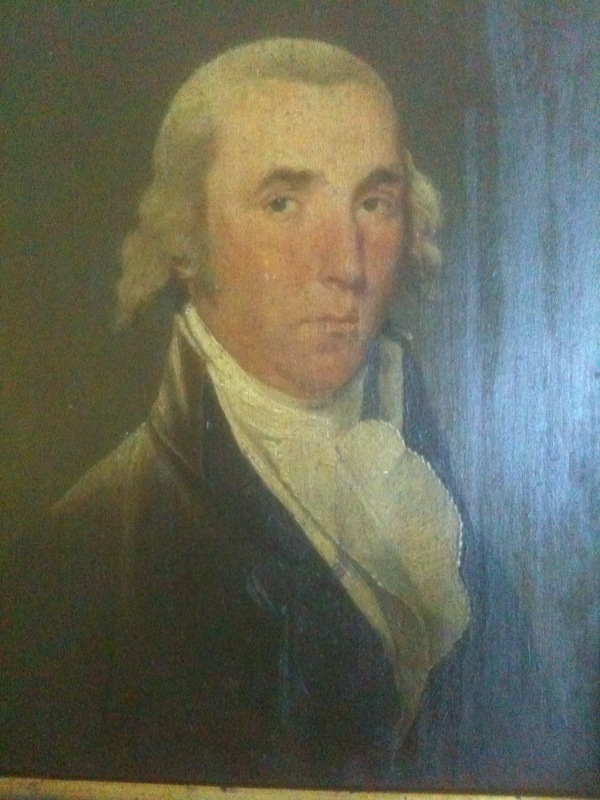 Robert was born in 1758 in Philadelphia. Nothing is known of his youth, but as the son of a successful merchant ship captain in a cosmopolitan city like Philadelphia, he would have received a good Grammar School education, at a minimum. There is no indication that he attended college. More likely he was apprenticed like his brother William. At right is a painting of Robert in middle age, provided by Michael S. Brown, a descendent of the the Ann Heysham Sayre line. The portrait is in his aunt's possession.
Robert was born in 1758 in Philadelphia. Nothing is known of his youth, but as the son of a successful merchant ship captain in a cosmopolitan city like Philadelphia, he would have received a good Grammar School education, at a minimum. There is no indication that he attended college. More likely he was apprenticed like his brother William. At right is a painting of Robert in middle age, provided by Michael S. Brown, a descendent of the the Ann Heysham Sayre line. The portrait is in his aunt's possession.
According to Theodore Heysham, a 19th century direct-descendent, Robert was an officer in the American Revolution. As we'll see, he did eventually attain a commission as an Ensign, but this was at the end of the war. A volunteer, he reportedly fought at the battle of Trenton in 1776, when he was 18 years old. Theodore Banta, in "The Sayre Family," also says he "was in the battle of Trenton, when only sixteen [sic] years of age, and continued through the Jersey campaign." Four companies of the Philadelphia militia did take part in the Trenton battle, fighting under General John Cadwallader, though they were not able to cross the river for the first attack because of the ice. The Battle of Trenton was famous, of course, for General Wasington's dramatic crossing of the Delaware river on Christmas Eve, commemorated in the familiar painting of the subject. There were two phases to the battle, and it was the second, when General Washington came back to occupy Trenton, that made the most use of the militia, which Robert would have been a member. By the way, Commodore John Barry [the father of the U.S. Navy] also took part, fighting with a marine group under General Cadwallader.
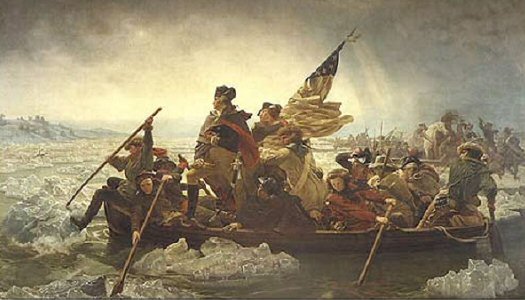
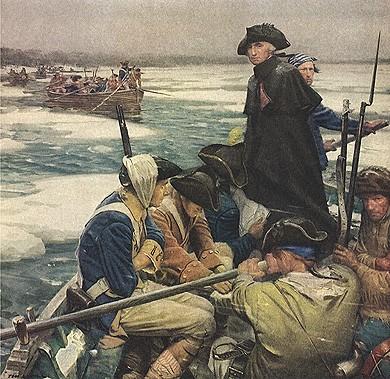
| Battle of Trenton
Since his defeat at Long Island General Washington had been on the retreat. In the fall of 1776 the American Army had ceded New York state and was being driven across New Jersey. In December Washington crossed the Delaware river into Pennsylvania. Wisely, his men destroyed all the boats on the east side of the river so that General Cornwallis could not follow. At this point the British went into winter quarters, spreading their troops out in a number of small detachments. In the American camp morale was low and enlistments were due to run out at the end of the year. Washington knew he had to get a victory and decided to recross the Delaware river and make a suprise attack, picking the remote Hessian garrison at Trenton. He decided to make a pre-dawn attack on the 26th. The weather, however, was frightful. Washington's aide, Colonel John Fitzgerald wrote at 6 PM as the troops started across: "It is fearfully cold and raw and a snowstorm is setting in. The wind northeast and beats into the faces of the men. It will be a terrible night for those who have no shoes. Some of them have tied only rags about their feet: others are barefoot, but I have not heard a man complain."In the midst of the storm, Washington's force attacked in two columns, led by Generals Nathanael Greene and John Sullivan. After a fast moving battle the Hessians, never able to overcome their initial surprise, were forced to surrender. By the next day the Washington's force was back across the river, safely in Pennsylvania. 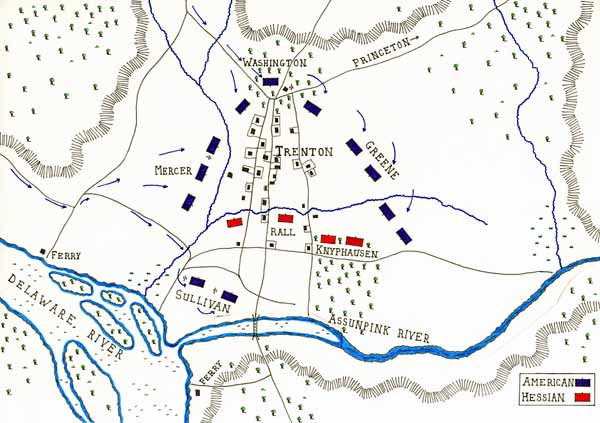 |
If Robert wasn't at the first battle of Trenton, he may have been at the second. After news of Washington's unexpected victory reached Philadelphia morale quickly recovered and many new militia reported for duty.
| The Second Battle of Trenton
On 27 December General Cadwallader, who had been unable to land on the Jersey shore on the 26th in support of Washington's attack, reported he was crossing near Burlington, reinforced by militia which was turning up encouraged by the previous night's victory. Cadwallader was unaware that Washington had recrossed the river and moved into the now empty Burlington and then to Bordentown, reporting that the citizens were hastily removing the red rags nailed to their doors as symbols of loyalty to the crown. He entreated Washington to join him in advancing on the British who were in a panic. Washington gathered all the troops he could, including many militia, recrossed the river, and began to entrench in Trenton. In the meantime, Geneal Cornwallis had been ordered forward with a superior force. Washington had built a strong position on the south side of the Assunpink creek and was able to repell several British attacks, but he knew his untrained militia could not be expected to continue to do so. During the night Washington quietly pulled out his army, leaving a few men behind to keep the campfires burning, make entrenchment noises, and keep up appearances, and moved the bulk of his army around the British force toward Princeton, outflanking Cornwallis. Again the weather helped General Washington when freezing temperatures turned the muddly roads to hard ice. The Battle of PrincetonThe next phase of the battle is known as the Battle of Princeton. Now behind Cornwallis' lines the Americans came upon a force of British regulars enroute to Trenton as reinforcements. After an initial clash and retreat, the Americans, encouraged by the forward presence of General Washington himself, regrouped and attacked, forcing the British to retreat into Princeton. These sought shelter in Nassau Hall, a college building. Under assault by General Sullivan's men, the British eventually surrendered. 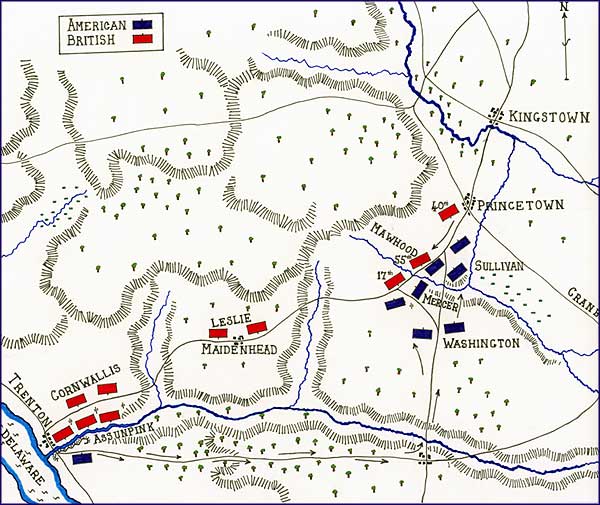 Cornwallis, meanwhile, discovering that the American army at Trenton had gone, moved his army towards Princeton to crush Washington between the two British forces. General Washington, however determined he had victories enough that day and moved his forces north out of harms way and went into winter quarters in Morristown, New Jersey. General Howe, shaken by the American victories, ordered a withdrawal from New Jersey to a line from Perth Amboy to New Brunswick. |
If Robert fought at Trenton, he probably fought at Princeton as well. See Banta's comments, above, that affirm this.
Robert applied for DI papers on 13 June 1777 (Nat. March 13, 1789) [?]. Importantly, on 13 June 1777 the Pennsylvania General Assembley had passed an Act requiring all men to take an oath of allegiance to the commonwealth and renouncing the authority of the King.
"I______, ________; do swear (or affirm) that I renounce and refuse all allegiance to George the Third, king of Great Britain, his heirs and successors; and that I will be faithful and bear true allegiance to the Commonwealth of Pennsylvania as a free and independent State, and that I will not at any time do or cause to be done any matter or thing that will be prejudicial or injurious to the freedom and independence thereof, as declared by Congress, and also, that I will discover and make known to some one justice of the peace of said State all treasons or traitorous conspiracies which I now know or hereafter shall know to be formed against this or any of the United States of America."Might DI refer to the Declaration of Independence that renounced the King?
The first muster I've found for Robert was in July 1777, well after the battles in Trenton.
Private 2nd Class Robert Hysham, of Philadelphia City, Active Duty Militia (served his tour), 4th Battalion, 5th Company of Captain Lambert Willmore [Wilmore, Wilimore], Called July 1777. - from the Pennsylvania Archives, Revolutionary War Military Abstract Card FileRobert was 19 years old. Unfortunately, I've found multiple musters for him at about the same time.
Robert Heysham, Private Fourth Class, served & belonged to Captain L. Willmore's Company, Captain George Esterly's Battalion - from "A General Return of the Third Battalion When Called into Actual Service July 1777"
At about the same time I have a muster roll of Captain Lazarus Pine's Fourth company of the Second battalion, Philadelphia Militia of Foot, in the service of the United States, commanded by Sharp Delany, Esq., Colonel. Under the list of Privates is Robert Heysham. The muster was taken at Billingsport, dated 12 July 1777. It looks like Robert was in several places at one time. Perhaps he was simply caught in the midst of changing units.
Billingsport was the site of a fort on the New Jersey side of the Delaware river, just below the fort at Red Bank, and part of the sea-ward defenses of Philadelphia. Tadeusz Kosciuszko, the Polish expatriate, designed the fortifications at the request of George Washington. The fort was constructed by troops from New Jersey, Pennsylvania, South Carolina and Virginia in the spring and summer of 1777. The fort was never finished. The fort fell to the British in 1777 after they had taken Philadelphia, using a land route. I suspect Robert was part of the fort's construction crew.
| Battle of Brandywine
During the winter of 1776/77 General Washington had rescued the revolution and given the British in New Jersey a setback with his victories at Trenton and Princeton. However, in the new year General Howe determined to take the city of Philadelphia. The City Council received intelligence of this and by April had begun to make preparations. A hundred wagons were called for to remove public stores to the west side of the Schuykill river. On 13 June the British Army made its first advance out of New Brunswick, New Jersey and on 14 June the Council ordered that the first class of militia should be immediately forwarded to camp, and the second class be ordered to march, and the third class be held in readiness to move on short notice. In early July, when intelligence was received that the British had returned to their barracks, the Council instructed the lieutenants of the counties of Philadelphia and Chester that it was unnecessary to move the second class of militia, but that it should be held in readiness to march at the shortest notice. On 20 July 1777, Congress received information that a British fleet of one hundred and sixty sail was in the Narrows, on the way to Sandy Hook. On the 22nd, Washington, perplexed as to the destination of Howe, requested that trustworthy persons should be stationed at the Capes of the Delaware to give prompt notice if the fleet should appear in that quarter. On the 30th the British fleet was spotted entering the mouth of the Delaware river, but General Howe, thinking it hazardous to continue up that river, instead moved the fleet into Chesapeake Bay. When the news of the arrival of the British fleet at the cape of the Delaware was received, Council prepared to meet the threatening attack, and as many of the militia were without guns, it was ordered that those persons, civilians, who had not taken the oath of allegiance to the colonies should immediately be disarmed, "and their arms made use of by those who are willing to risk their lives to defend their liberties and property." By 20 August intelligence had been received that the British fleet was in the Cheseapeake and General Washington gave orders to move the continental Army and the various militia's south. On the 23d the Continental army broke camp and moved for Philadelphia, through which city it passed early the next day, August 24th (Sunday), marching down Front Street to Chestnut, and up Chestnut to the Middle Ferry, Washington himself riding at the head of the column and Lafayette at his side. That evening the army encamped in and about Chester, and the next evening (the 25th) they reached Wilmington. 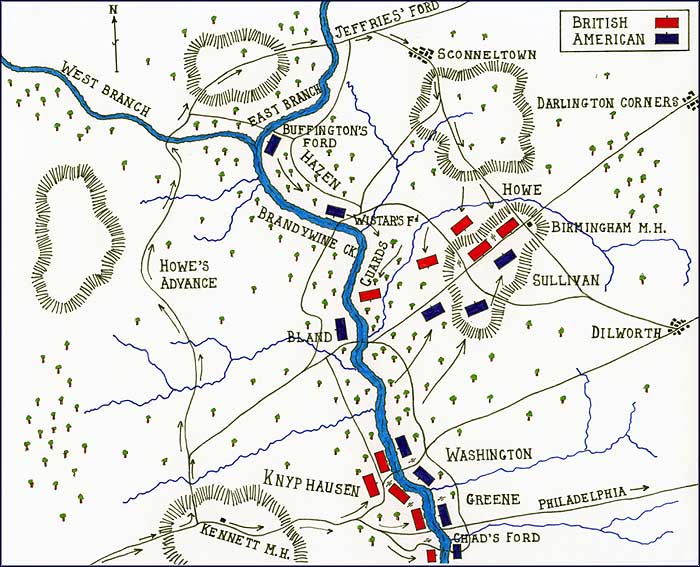 The British approached from the south in two columns and General Washington realized they intended to outflank his right and cut him off from Philadelphia. He immediately ordered the army north and recrossed the Brandywine river to take up position on high ground at Chad's Ford. The Pennsylvania militia, under General John Armstrong, constituted the left-wing. On the morning of 11 September the British attacked, their movements hidden by a thick fog. Their plan was to split their forces, sending a detached force under General Cornwallis to turn the American's right flank, crossing the river at an unprotected ford. The British succeeded and the Pennsylvania militia, which had taken no active part in the battle, fled with the rest of the American soldiers, and joined the demoralized body, which then almost choked the Concord road with a struggling mass of panic-stricken men hastening wildly in the direction of Chester. By 25 September General Howe was in Philadelphia. |
Private Second Class Heysham undoubtedly saw much marching to and fro in this campaign, and spent some wet uncomfortable nights sleeping in the entrenchments, but could probably tell little of what had actually happened at the battle. When the army's position collapsed, Robert probably hot-footed it north with his comrades, asking, "What happened?" Theodore Heysham, a direct-descendent of the 19th century, claimed Robert was a prisoner of war from 1777-1778. If so, then during the retreat from the Brandywine river seems a likely time to have been scooped up. This makes sense since the militia was the last to know that a rout had begun. Another reference, which I've suggested refers to Robert's father, William Heysham, simply says that "Heysham" was taken when Howe entered the city. Perhaps Theodore saw this as referring to Robert.
Soon after the British entered and took Philadelphia. As a prisoner of war, Robert would have found himself jailed at the Walnut Street prison. Robert's father, William, had been arrested as a prominent rebel at about this time so the two may have been reunited in jail.
| The Walnut Street Prison
The old jail, on the southwest corner of Market and Third, was replaced by a more substantial one on Walnut street, though the earlier jail was still in use in 1777-1778. "On Walnut Street, near Sixth, was the prison used as the British Provost in 1778. It was under the charge of that infamously cruel scoundrel, Captain Cunningham, a burly, ill-natured Irishman of sixty years, whose conduct as provost marshal here and in New York has connected his name with all that is detestable. There were confined the American prisoners taken at Brandywine and Germantown, many of whom died of starvation after feeling the lash of Cunningham's whip, or the force of his heavy boot, and were buried in the Potter's Field near by, now the beautiful Washington Square. It makes the blood curdle to read of the sufferings of those who fell under the sway of that monster, so devilish in all his ways. The miseries of others seemed to give him great delight; and often, in the sight of the starving prisoners, would he kick over a pail of soup, or scatter a basket of fruit or cold victuals which some benevolent hand had placed upon the door-stone with the hope that it might nourish the famished soldiers! We shall meet him hereafter as provost marshal in New York. Tradition says he was hung at Newgate, in England; but the records of that prison, examined by Mr. Bancroft, exhibit no such name." - from Watson's "Annals of Philadelphia"  |
The British retreated from Philadelphia in June 1778 after the French entered the war.
Private 4th Class Robert Heysham, of Philadelphia City, Inactive Duty Militia, 3rd [garbled] County Battalion, 1st Company of Captain George Esterly, Called in August 1778. Served and released [garbled] to Captain L. Wilmore's Company.This was probably an administrative call-up in the aftermath of the "invaders" withdrawal.
I believe that according to an "Act of Assembley passed 5th December, 1778, in the city of Philadelphia" a modified oath of allegiance was required of all adult males. The wording of the oath was differrent from that required in the Act of 13 June 1777. The oath is substantially the same, but it mentions the Declaration of Independence and affirms that the oath maker did not aid, assist, abet or countenance the King and his armies. Robert took this new oath of allegiance to the patriot cause in October 1779.
"1779Robert was 21 years old at the time. What does the latter phrase in the reference mean? I don't think it means that Robert was an elected official, rather that he had elected to take this oath. Neither Robert's brother or father were listed. This makes sense for William Jr. if we accept that he was in the Old Mill prison in England at the time, but why didn't William Sr take the oath? Perhaps it's simply that his oath taking was not recorded or the recording was lost.
Oct. 9
. . .
12, Robert Heysham, of Philada., Mercht.
. . .
Lists of the foregoing returned to Election at State House." - from "Persons Who Took the Oath of Allegiance to Pennsylvania Between the Years 1777 and 1789"
The following reference records the same oath.
"12 October 1779
Robert HeyshamThe foregoing names are a list of persons who took and subscribed the oath of allegiance and fidelity as directed by the Act of General Assembly, and returned this 12th day of October, 1779, by
- from the "Muster Rolls and Papers Relating to the Associators and Militia of the City and County of Philadlephia"
James Young."
Robert continued to serve in the Pennsylvania militia.
Private 2nd Class Robert Heysham, of Philadelphia City, Inactive Duty Militia, 5th Company of Captain Lambert Wilmore, 4th County Battalion - from a unit muster roll for the period, dated 1777-1779In 1789 Robert was assigned as a quarter master, part of the Supply department.
Deputy [Company] Quarter Master, Third Class, Robert Heysham, of Philadelphia City, Active Duty Militia, 3rd County Battalion, 3rd Company of Captain George Esterly, Called 10 August 1780, Served His TourAs the son of a merchant of Philadelphia, and a merchant himself, Robert was in a good position, and had the experience, to be a quarter master. To what extent, I wonder, did he serve as an assistant to his father, who was also probably working on the Supply side?
In 1779-1780 the British were embarked on a campaign to win over the South. General Cornwallis had several significant victories in Georgia and South Carolina. In September 1780 he continued north, plunging into North Carolina. A year later he found himself trapped at Yorktown, Virginia and forced to surrender.
In about 1780 Robert was commissioned an Ensign, at that time the lowest officer rank in the infantry.
Ensign Robert Heysham, of Philadelphia City, Inactive Duty Milita, Lt. Col. William Will, 3rd County Battalion, 3rd Company of Captain George Esterly - from a unit muster roll for the period, dated 1780-1781Robert was 22-23 years old at this point. His name, and new rank, were also included in the "Return of Officers to be Commissioned Who Were Legally Chosen for the City Philadelphia and Districts Militia," dated 28 May 1781. A similar return, dated 7 May 1783, also lists Robert under the name Hysham, as an Ensign in the 4th Battalion. However, from a card that is otherwise the same as above, dates included, Robert Heysham was listed as a Private 3rd Class.
The Effective Supply Tax of the city of Philadelphia for 1781 lists William Heysham with a Valuation of 950 and a Tax of 9.17.10. I believe, based on the valuation, that this is William Sr. His eldest son, Robert, is listed below him with a zero valuation and Tax of 1.0.0.
In 1782 Robert Heysham, or his father William, was involved in a court case, Burrows versus Heysham. I'll admit I don't know what this was about, even after reading the decision. Scire facias [a writ requiring a person to show why a judgment should not be enforced] against special bail was allowed to be amended by the record, substituting "September, 1782," for "December, 1781," even though a writ of error had been brought removing the judgement. A writ of error is a demand by the appellate court to review a case in which a legal error is alleged to have been committed in a lower court. Special bail is the act by which a persoh becomes specially bound to answer for the appearance of another. The opinion was delivered by Edward Shippen, President of the Court of Common Pleas, on 20 August 1785. Apparently this was an administrative action to clean up the record not impacting the case itself, which was rejected.
In 1783 the war was over and America was independent.
"Congress presided over the liquidation of the fast-shrinking Continental Army and in 1784 constituted a small replacement consisting of men drawn from the militias of Connecticut, New York, New and Pennsylvania, to serve for one year unless discharged sooner. It placed Lieutenant Colonel Josiah Harmar, from the Pennsylvania militia, in command. At the end of the first year, Congress voted to sustain the unit for three additional years. Thus, without drawing substantial contemporary notice, a militia force became in 1785 the nucleus of the original regiment of the United States regular army."Robert Heysham probably became a Captain of the militia at this time, apparently in the 3rd regiment.
 Robert soon got a federal job working for Robert Morris, at left, in the Office of Finance. Morris must have forgiven Robert's father, William Heysham, for his role in investigating Morris for the Poleacre Victorious scandal.
Robert soon got a federal job working for Robert Morris, at left, in the Office of Finance. Morris must have forgiven Robert's father, William Heysham, for his role in investigating Morris for the Poleacre Victorious scandal.
13 January 1783. "Mr. Robert Heysham engaged as a Clerk in this Office this Day being well recommended."
Footnote. "Robert Heysham served as clerk in the Office of Finance until it was replaced by the Board of Treasury in 1785. He was later a member of the predominantly Federalist Second Troop of Philadelphia City Cavalry." - from "The Papers of Robert Morris" by John Catanzariti
"List of Officers Employed in the Departments of Finance and Marine [Philadelphia, March 4-10, 1783]Note that while the Battle of Yorktown had been won in October 1781, and the war in America was "effectively" over, a British army still occuppied New York City and a peace treaty was not signed until September 1783.
Hon. Robert Morris Esqr. Superintendent $6,000
Gourverneur Morris Esqur. Assistant $1,850
. . . Robert Heysham Clerk $500
. . ." - from "The Papers of Robert Morris, 1781-1784."
4 March 1783. "List of Persons employed in the Office of Finance
Names . . . Stations . . . Salarey per Annum . . . Amount
Hon. Robert Morris Esqr. . . . Superintendent . . . 6,000
. . .
Robert Heysham . . . Clerk . . . 500" - from "The Papers of Robert Morris" by John Catanzariti
| The American Government, 1783-1789
In February 1781 Robert Morris was appointed the first U.S. superintendent of finance while the country was still fighting for its independence. He selected New York's Gouverneur Morris as his assistant minister of finance. In November 1784 the office was replaced by the Treasury Board and by the Treasury Department when the Constitution was ratified in 1789. |
In addition to his government job, Robert may have had a commercial or private relationship with Robert Morris.
10 May 1784. "Articles of Partnership of Robert Morris, Gouverneur Morris and William ConstableRobert was in the finance office until 1785. What he did from then until he got a federal job in 1789 I do not know. Robert had been earlier identified as a merchant, probably working with his father. While he had other occupations throughout his life, he may have kept his hand in as a merchant. Note that his widow, Mary, had a Drygood store at 48 North 6th street in the 1820's. It is likely this was an inheritance from Robert, vice a new start-up.
. . . a joint Copartnership of Merchants, under the firm of William Constable & Company . . .
Seal and Deliverd
Robt Morris, Gouv Morris, Wm. Constable
In the presence of Jos: Stretch, Robt Heysham" - from "The Papers of Robert Morris, 1781-1784."
Robert had a warrant for 400 acres in Northumberland county dated 1 July 1784. The tract was located on the "W. Br. of Wyalusing Crk." There was no plat map created. The Date of Return for the survey showing only, "Appropriated." By whom? See Wyalusing. The Wyalusing is a tributory of the Susquehanna river.
Robert received another warrant in Northumberland county on 27 July 1787. The patentee was Henry Drinker.
In the first years of the United State's existence the country was governed under the Artilces of Confederation which kept the central authority weak. It quickly became apparent that this did not work well and delegates from the states gathered in Philadelphia in 1787 to consider a new constitution for a federal government. By September an agreement had been reached. On 4 July 1788, a parade honoring the establishment of the Constitution of the United States was held in Philadelphia. Fourteenth in line in the parade was a Corps of Light-Infantry, commanded by Capt. Heysham, from the 3d regiment.
| The Federal Procession of 1788
Following the signing of the Constitution on September 17, 1787, the document was submitted to the states for their approval. Francis Hopkinson, poet, judge, and signer of the Declaration of Independence planned a huge celebration in Philadelphia for July 4, 1788, when it was projected that the minimum number of states needed for ratification would be met. It was to be the largest civic event the nation had ever seen.
It was computed that five thousand walked in the procession; and that as many as seven thousand were assembled on the "Union Green" where the procession ended, in front of Bush-hill. Many cities held their own processions. At right is a drawing of the parade in New York City. The following is the "Order of Procession, in honor of the establishment of the Constitution of the United States. To parade precisely at Eight O'Clock in the Morning, of Friday, the 4th of Julu, 1788, proceeding along Third-street to Callowhill-street; thence to Fourth-street; down Fourth-street to Market-street; thence to the Grounds in Front of Bush-hill." I. An Officer, with twelve Axe-men, in frocks and caps.II. The City Troop of Light-Horse [dragoons], commanded by Colonel Miles. III. INDEPENDENCE. John Nixon, Esq; on horseback, bearing the staff and cap of Liberty---The words, "4th July, 1776," in gold letters, pendant from the staff. IV. Four Pieces of Artillery, with a detachment from the Train, commanded by Captains Morrell and Fisher. V. ALLIANCE WITH FRANCE. Thomas Fitzsimons, Esq; on horseback, carrying a flag, white ground, having three fleurs-de lys and thirteen stars in union, over the words "6th February, 1778," in gold letters. VI. Corps of Light-Infantry, commanded by Capt. Claypoole, from the 1st regiment. VII. DEFINITIVE TREATY OF PEACE. George Clymer, Esq; on horseback, carrying a staff, adorned with olive and laurel, the words "3d September, 1783," in gold letters, pendant from the staff. VIII. Col. John Shee, on horseback, carrying a flag, blue field, with a laurel and an olive wreath over the words--- "WASHINGTON, THE FRIEND OF HIS COUNTRY" ---in silver letters---the staff adorned with olive and laurel. IX. The City Troop of Light Dragoons, commanded by Major W. Jackson. X. Richard Bache, Esq; on horseback, as a Herald, attended by a trumpet, proclaiming a New Era--- the words "NEW ERA," in gold letters, pendant from the Herald's staff, and the following lines, "Peace o'er our land her olive wand extends, And white rob'd Innocence from Heaven descends; The crimes and frauds of Anarchy shall sail, Returning Justice lifts again her scale." XI. The Hon. Peter Muhlenberg, Esq; Vice-President of Pennsylvania, on horseback, carrying a flag, blue field, emblazoned---the words, "17th September, 1787," in silver letters, on the flag. XII. Band of Music. XIII. The Honorable Chief-Justice M'Kean, The Hon. Judge Atlee, The Hon. Judge Rush, (in their Robes of Office) In an ornamented Car, drawn by six horses, bearing the CONSTITUTION, framed, fixed on a staff, crowned with the Cap of Liberty-----the words--- "THE PEOPLE," in gold letters, on the staff, immediately under the Constitution. XIV. Corps of Light-Infantry, commanded by Capt. [Robert] Heysham [called Haysham's infantry in Watson's Annals], from the 3d regiment. XV. Ten Gentlemen, representing the States that have adopted the Federal Constitution, viz. 1. Duncan Ingraham, Esq; .......... New-Hampshire, 2. Jonathan Williams, jun. Esq; .......... Massachusetts. 3. Jared Ingersoll, Esq; .......... Connecticut. 4. Hon. Chief Justice Brearley, .......... New-Jersey. 5. James Wilson, Esq; .......... Pennsylvania. 6. Col. Thomas Robinson, .......... Delaware. 7. Hon. J. E. Howard, Esq; .......... Maryland. 8. Col. Febiger, Virginia. 9. W. Ward Burrows, Esq; South-Carolina. 10. George Meade, Esq; .......... Georgia. Bearing distinguishing flags and walking arm in arm, emblematic of Union. XVI. Colonel William Williams, in armour, on horseback, bearing a Shield, emblazoned with the arms of the United States. XVII. The Montgomery county Troop of Light-Horse, commanded by James Morris, Esquire. XVIII. An ornamented Car, drawn by four horses, bearing Captain Thomas Bell, carrying the Flag of The United States, ---Monsieur Bar de Marbois, Flag of France, ---Mr. Hennekin, Flag of The United Netherlands, ---Mr. Helstead, Flag of Sweden, ---Mr. Lecke, Flag of Prussia, --- Thomas Barclay , Esquire, Flag of Morocco, ---States in alliance with America. XIX. The Judge, Register, Marshal, and other Officers of the Court of Admiralty, with their insignia. XX. Wardens of the Port, and Tonnage Officers. XXI. Collector of the Customs, and Naval Officer. XXII. The Surveyor-General, Receiver-General, Secretary, and other Officers of the Land Office. XXIII. Register, Recorder of Deeds, and Comptroller-General. XXIV. Peter Baynton, Esq; and Colonel Isaac Melcher, as an American and an Indian, smoaking the Calumet of Peace, in a carriage drawn by two horses. XXV. GRAND FDERAL EDIFICE, on a carriage drawn by ten horses, containing Messrs. Hilary Baker, George Latimore, John Wharton, John Nesbitt, Samuel Morris, John Brown, Tench Francis, Joseph Anthony, John Chaloner and Peter Ozeas, citizens of the Union.----- Attended by the House-carpenters. XXVI. Corps of Light Infantry, commanded by Captain Rose, 5th regiment. XXVII. The Agricultural Society, headed by their President, S. Powel, Esq; XXVIII. The Farmers, headed by Richard Peters, Richard Willing, Samuel Meredith, Isaac Warner, George Gray, William Peltz, ------ Burkhart and Charles Willing, with ploughs, &c. XXIX. The Manufacturing Society, with the spinning and carding machines, looms, &c. headed by Robert Hare, Esq; Corps of Light Infantry, commanded by Capt. Robinson, from the 6th regiment. The Marine Society, with their insignia. The Federal Ship, The UNION, commanded by John Green, Esq; Captain S. Smith, W. Belchar and Mr. Mercer, Lieutenants, with a proper crew of Officers and Seamen. [per "History of Philadelphia 1609-1884," "Capt. Greenaway, carrying a globe, supported by Capts. [William] Heysham and Alberson, with spyglasses in their hands] The Pilots of the Port, with a Pilot Boat. Boat Builders, with a Barge. The Ship-carpenters, Sail-makers, Rope-makers, Block-makers and Riggers. The Merchants and Traders of the city and liberties of Philadelphia, headed by Thomas Willing, Esq; with their insignia---followed by the Merchants Clerks. Corps of Light Infantry, commanded by Capt. Sproat, from the 4th regiment. TRADES and PROFESSIONS. XXX. 1. Cordwainers. XXXI. 2. Coach painters. XXXII. 3. Cabinet and Chair-makers. XXXIII. 4. Brick-makers. XXXIV. 5. Painters. XXXV. 6. Porters. XXXVI. 7. Watch-makers. XXXVII. 8. Fringe and Ribband Weavers. XXXVIII. 9. Bricklayers. XXXIX. 10. Taylors. XL. 11. Instrument-makers, Turners and Windsor Chair-makers. XLI. 12. Carvers and Gilders. XLII. 13. Coopers. XLIII. 14. Plane-makers. XLIV. 15. Whip Manufacturers. XLV. 16. Black-smiths, White-smiths, Nail-smiths and Bell-hangers. XLVI. 17. Coach-makers. XLVII. 18. Potters. XLVIII. 19. Hatters. XLIX. 20. Wheel-wrights. L. 21. Tin-plate Workers. LI. 22. Skinners, Breeches-makers and Glovers. LII. 23. Tallow-chandlers. LIII. 24. Butchers. LIV. 25. Printers, Stationers and Book-binders. LV. 26. Saddlers. LVI. 27. Stone-cutters. LVII. 28. Bakers. LVIII. 29. Gun-smiths. LIX. 30. Copper-smiths. LX. 31. Gold-smiths, Silver-smiths and Jewellers. LXI. 32. Distillers. LXII. 33. Tobacconists. LXIII. 34. Brass-founders. LXIV. 35. Stocking Manufacturers. LXV. 36. Curriers. LXVI. 37. Druggists. LXVII. 38. Upholsterers. LXVIII. 39. Sugar-refiners. LXIX. 40. Brewers. LXX. 41. Peruke-makers and Barbers. LXXI. 42. Ship-chandlers. LXXII. 43. Engravers. LXXIII. 44. Plaisterers. Corps of Light Infantry, commanded by Capt. Rees, from the 2d regiment. The Civil and Military Officers of Congress in the City. His Excellency the PRESIDENT, and the SUPREME EXECUTIVE COUNCIL. The Justices of the Common Pleas and the Magistrates. Sheriff and Coroner, on horseback. City Wardens. Constables and Watchmen. The gentlemen of the Bar, headed by the Honorable Edward Shippen, Esquire, President of the Common Pleas, and William Bradford, Esquire, Attorney-General, followed by the Students of Law. The Clergy of the different denominations. The College of Physicians, headed by their President, Dr. Redman. Students of the University, headed by the Vice-Provost, and of other Schools, headed by their respective Principals, Professors, Masters and Tutors. The County Troop of Light Horse, commanded by Major W. Macpherson, bringing up the rear of the the whole. Major Fullerton to attend the right wing------Colonel Mentges the left wing. On the UNION GREEN, at Bush-hill, Mr. WILSON will deliver an Oration, suited to the day; after which a Collation will be prepared for the company. The following gentlemen, distinguished by a white feather in the hat, are Superintendants of the procession. General Mifflin, General Stewart, Colonel Proctor, Colonel Gurney, Major Moore, Major Lenox, Mr. Peter Brown, Colonel Will, Colonel Marsh. To add to the entertainment of the day, ten vessels will be prepared and paraded as follows, one representing New-Hampshire, opposite the Northern-Liberties,---the next for Massachusetts, opposite Vine-street,--- Connecticut, opposite Race-street,--- New-Jersey, Arch--- Pennsylvania, Market--- Delaware, Chestnut--- Maryland, Walnut--- Virginia, Spruce--- South-Carolina, Pine---and Georgia, South-street. The RISING SUN, under the command of Captain Philip Brown, will be anchored off Market-street, and superbly dressed. At night she will be handsomely illuminated. By Order of the Committee of Arrangement, Francis Hopkinson, Chairman. |
At the end of the parade James Wilson, Esq., gave an oration. "The several light companies were then drawn off by Capt. Heysham to an eminence nearby opposite, where they fired a feu de joie of three rounds, also three volleys, followed by three cheers, to testify their satisfaction on this joyful occassion." - from "Philadelphia History, 1609-1884."
George Washington was unanimously elected the first President of the United States with John Adams as his Vice President. While political parties had not yet coalesced, those in favor of a strong central government, such as Washington and Adams, soon became known as Federalists. Those opposing them, such as Jefferson and Madison, as Republicans.
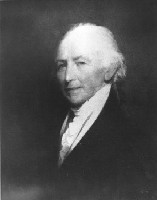 Robert was an adherent of General McPherson and later of Alexander Hamilton, both Federalists. As such Robert sided with the "aristocratic" tendencies of an organization that felt that the government of the country should be in the hands of the "better sort of people," like himself. Note below that one of Robert's sons was named Alexander Hamilton Heysham.
Robert was an adherent of General McPherson and later of Alexander Hamilton, both Federalists. As such Robert sided with the "aristocratic" tendencies of an organization that felt that the government of the country should be in the hands of the "better sort of people," like himself. Note below that one of Robert's sons was named Alexander Hamilton Heysham.
It was common practice at this time to reward supporters with government offices. When a party lost the White House federal workers were fired en masse, to be replaced by adherents of the new party in power. This was known as the Spoils System and was finally halted with the passage of the Civil Service Act. The Federalists held the executive from 1789 to 1801. Robert Heysham was given the position of Engrossing Clerk of the Senate of the United States, which he held from before 29 September 1789 to at least 8 January 1791. He worked for Samuel Otis, left.
"SenateThe engrossing clerk engrossed, that is, made changes in, the bills as they were introduced and amended.
John Adams, Vice President
John Langdon, President pro tempore
Samuel A. Otis, Secretary
Benjamin Bankson, Principal clerk
Robert Heysham, engrossing clerk
Samuel A. Otis, Jr., engrossing clerk
James Mathers, doorkeeper,
Cornelius Maxwell, messenger to the Senate,
Samuel Provost, Chaplain to the Senate in New York
William White, Chaplain to the Senate in Philadelphia" - from "Independent Offices Appropriation Bill for 1950 . . ."
The 1st United States Congress met at Federal Hall in New York City on 4 March 1789 and remained in that city for its initial two sessions. Robert Heysham appears to have continued to live in Philadelphia during this period, only going to New York when the Senate was in session.
| Locating the Capital
The Constituion, establishing a strong federal government, was adopted in September 1788 and elections were held in January 1789 for a New President and Congress. George Washington, the first President, delivered his inaugural address in New York City on 30 April 1789 from the balcony of Federal Hall overlooking Wall Street. His statue marks the spot today. The first sessions of the federal Congress were held in New York City from March 1789 to August 1790. In August 1789 the new Congress again took up the question of the nation's capital, however the issue was not resolved until July 1790 when the Residence Act was signed, establishing the current Potomac river site. It was also decided to move the temporary capital from New York City to Philadelphia while construction was completed at the new Federal City. From December 1790 to late in 1800 Philadelphia was the Capital of the United States. |
The third session of Congress met in Philadelphia where the federal government remained for the next decade. The Congress met at Congress Hall in Philadelphia from 6 December 1790 to 14 May 1800.
| Congress Hall, Philadelphia
|
The following were some of the expenses for which Robert was reimbursed as Engrossing Clerk.
Note that Alexander Hamilton was the Secretary of the Treasury in George Washington's administration and so would have paid government employees for the expenses of their duties. In 1790 "Robert Heysham, engrossing Clerk to the Senate" received $202.00 in pay. - from "Journal: 1st-13th Congress." In 1790 the First Congress adjourned from New York to Philadelphia for its third session.Robert Heysham engrossing Clerk in the Office of
the Secretary of the Senate.
____________________________________________
1789 Septemr 29 To Warrant No. 65 202. [dollars or pounds]
1790 March 31 To Warrant No. 272 100.
1790 April 7 To Warrant No. 379 174.
1790 August 24 To Warrant No. 631 168.
1791 January 8 To Warrant No. 822 78.
822.
- from "The Papers of Alexander Hamilton"
"To Robert Heysham principal Clerk in the Office of the Secretary of the Senate for his expenses incurred by the removal from New York to Philadelphia--Warrant No. 1139" - from "Papers of Alexander Hamilton" by Harold C. Syrett
Robert Heysham of Philadelphia city was a Captain of the Pennsylvania Militia, Light Infantry, 4th Battalion, from 1789 to 1792 - from the Pennsylvania Archives, Militia Officers Index Cards, 1775-1800. This was probably as part of service in Indian uprisings in northwestern Pennsylvania from 1789 to 1795. Two major military expeditions took place. The first, in 1790, was led by General Josiah Harmer. The second, in 1791, was led by General Arthur St. Clair. Both expeditions were defeated by the Indians. To pay for this military activity it was decided to put an additional tariff on the sale of whiskey. This action would become important in 1794.
In the 1790 census of Philadelphia there were three men living in the household of William Heysham at 107 Arch Street. These were probably William Sr., William Jr., and Robert.
In 1790 Robert witnessed the will of Francis Hopkinson, Esquire. He was a poet and Judge of the District Court of Pennsylvania. The will was signed on 30 August 1790. Wife- Ann. Children- Joseph, Francis, Mary, Elizabeth, Ann. Sisters- Ann Coole, Jane, Elizabeth Duche. Negro Slaves- Dan, Violet. Exec. Ann and Joseph Hopkinson. Friend and Trustee- Alexander Wilcocks. Witnesses- Jn. Gibbons [Robert's brother-in-law], Robt. Heysham, John Wilcocks Junr. Provd. May 24. 1791.
- Robert was clearly traveling in exalted company, see below. I suspect Gibbons and Heysham were chosen as witnesses because of their proximity. Alexander Wilcocks lived between Gibbons and Heysham on Arch Street.
| Friends & Witnesses
Alexander Wilcocks An attorney of Philadelphia. He lived at 105 [or 324] Arch Street, between Doctor John Gibbons and William Heysham, in the period from 1783 and 1791. He married Mary Chew. Benjamin Chew, her father, was a Chief Justice and important in the runup to the Revolution. Alexander was a Chairman of the Committe of Safety in 1776. Recorder of the City of Philadelphia from 1798 to 1801. He died in July 1801. John WilcocksAlexander's brother. A Philadelphia merchant and member of the city council, he died in January 1798. He served with William Heysham in the Second Division on the Committee of Inspection and Observation. |
On 24 March 1791 Robert's mother, Mary, died at the age of 68.
In 1791 Robert Heysham received, for his pay, $258.00 - from "Journal: 1st-13th Congress." He was still the engrossing clerk at this time. Robert Heysham (Haysham) then became the "principal clerk, office of secretary of U.S. Senate" replacing Benjamin Bankson - from "The Papers of Alexander Hamilton." He appears to have held this job from as early as the summer of 1791 to as late as 1803.
24 June 1791, "To Robert Heysham principal Clerk in the Office of the Secretary of the Senate for his expenses incurred by the removal from New York to Philadelphia-Warrant No. 1119." The expenses covered appear to be "12." dollars [?] - from "The Papers of Alexander Hamilton"
| The Principal Clerk of the Senate
The Secretary of the Senate is an elected officer of the Senate. He supervises a number of offices and services to expedite the day-to-day operation of the Senate. The first Secretaries kept the minutes and records of the Senate, and purchased supplies. The first Secretary, Samuel Allyne Otis, was chosen on April 8, 1789. Otis had previously been quartermaster of the Continental army, speaker of the Massachusetts house of representatives, member of Congress under the Articles of Confederation, and John Adams' long-term ally. Otis held the post of Secretary for 25 years, never missing a day that the Senate was in session. The first Secreatary was authorized to hire one principal clerk, who served primarily as a reading clerk on the Senate floor. That is, he read the bills, motions, and other papers before the Senate. He also called the roll for voting. His pay was $1300 a year. Note that when the British invaded and burned Washington D.C. during the War of 1812, the Secretary of the Senate, Samuel A. Otis, was dead and had not yet been replaced. The important task of safe-keeping the Senate's records therefore fell to his principal clerk. There was a clerk and two door-keepers under the Principal Clerk. |
Robert's name is found in a webpage dedicated to those who served in the Legion of the United States, a military unit under the command of Anthony Wayne, between 1792 and 1796.
"Hoysham, Robert" - from "Equipment and Supply List for the US Army 1790-1796," page 5However, I suspect Robert's name was appended to this List in his role as Principal Clerk.
| The Legion of the United States and Legion Ville
"It was 201 years ago (Nov.28, 1792) when Maj. Gen. "Mad" Anthony Wayne and the Legion of the United States landed near present-day Ambridge, Pennsylvania after floating four hours on 50 barges down the Ohio River from Pittsburgh. There, on a bluff overlooking the Ohio River, between 2,000 and 2,500 enlisted men, mostly raw recruits, built Legion Ville, a camp of 500 structures where Wayne began the creation of what would become the United States Army." President George Washington had commissioned Wayne a major-general and Commander-in-Chief of the newly legislated Legion of the United States, and ordered him to create a disciplined fighting force capable of subduing the Indians on what was then the northwestern frontier. "At Legion Ville, Anthony Wayne drilled his troops unmercifully and insisted on strict discipline; flogging and court- martialing offenders. He also instilled pride and espirit de corps, however, by distributing frequent rewards and designing elegant uniforms with distinctive colors for the various units . . . In 1794 Wayne defeated an alliance of Indians under the command of Shawnee War Chief Blue Jacket at the famous Battle of Fallen Timbers. The resultant Treaty of Greenville in 1795 opened up two thirds of Ohio and a portion of Indiana to white settlement, and in 1796 Wayne formally accepted the surrender of all seven of the British garrisons along the Great Lakes." |
In 1793 a Robert Heysham owned 400 acres of land in Northampton township. This may be a 'land deal' of Captain William Heysham's son or a previosuly unknown son of Thomas Heysham of Lower Smithfield township, Northampton county.
From a letter from Ebenezer Hazard to Samuel A. Otis, in Philadelphia, on 12 October 1793, "Robert Heysham has been slightly disordered, but is among the living, and the fat, and, no doubt, will attend to your house: the situation of my own puts it out of my power." - from "Collections of the Massachusetts Historical Society." Ebenezer Hazard was Postmaster General of the United States from 1782 to 1789. He died in Philadelphia in 1817. Samuel A. Otis was was Secretary of the Senate and Robert's boss.
Theodore Banta, in "The Sayre Family," says "He [Robert Heysham] acted as adjutant under Gen. William McPherson, during the insurrection in Western Pennsylvania." McPherson, only a Major at this time, commanded a volunteer troop of "gentlemen infantry" known as McPherson's Blues.
"M'Phersons Blues.They numbered about 1500 men. Note that McPherson's name is often spelled MacPherson. I've chosen the shorter version throughtout.
The Corps are desired to parade in Uniform on Saturday next at 9 o'Clock A.M. in front of the State-House; with their Arms, accoutriments, ammunition, Knapsacks, and every other public property in their possession, for the purpose of delivering up the same,
By order of the Colonel.
Robert Heysham Adjt.
December, 22, 1794 [misprinted as 1724]." - from the "Gazette of the United States" of 23 December 1794
| The Whiskey Rebellion
The tax of whiskey, which was supposed to pay for military action against the Indians, was, like the tax on tea a generation earlier, the proximate cause of the rebellion, but it was simply a symptom for a generalized discontent. State government power in the area was weak and separatist feelings were high. Courthouses were few and the local militia had to handle the many Indian attacks without support from the east. The British, who had kept troops in America in violation of the peace treaty, also took the opportunity to stir up trouble in the region. In 1794 General Anthony Wayne defeated a force of British and Indians at Fallen Timbers and it was only then that the British finally withdrew into Canada. The rebellion was the first real test of the new American government and whether it had primacy over the states. To combat the rebellion President Washington called out 13,000 troops from Pennsylvania, Virginia, Maryland and New Jersey. The insurrection collapsed as soon as these troops arrived. |
| General William McPherson
McPherson was born in Philadelphia in 1756 and educated at Princeton. An officer in the British army, he resigned his commission on the commencement of the revolution. In 1779 General Washington appointed him a brevet Major in the American army. On 19 September 1789 he was appointed Surveyor of the Port of Philadelphia and, in 1792, Inspector of the Revenue for the port. From 1793 to 1813 he was the port's Naval Officer, having been continued by the successive administrations of Presidents Adams, Jefferson and Madison. In 1794 during the Whiskey rebellion Major McPherson led a volunteer battalion styled "McPherson's Blues" under the overall command of Governor Frelinghuysen. On the threatened war with France, in 1798, the "Blues" were re-organized and on 11 March 1799 General McPherson was appointed Brigadier General of the Provisional army and commanded the troops sent into Northampton county to suppress John Fries rebellion [See John Fries Rebellion]. After the Provisional army was disbanded General MacPherson retired to his country seat, near Philadelphia, where he resided until his death on 5 November 1813. He was an original member of the Pennsylvania Society of the Cincinnati, and vice-president to his death. There is a reference in a reveiw of Richard N. Rosenfeld's "American Aurora: A Democratic-Republican Returns" to "The thrust and counter-thrust of the newspaper war, as the threats posed by the black cockade gangs and McPherson's Blues in 1798 imposed themselves on the Republicans, as the sense of the Republican's becoming a beleaguered minority grew . . ." Note that McPherson's men wore a black cockade. Was there a fiercer side to McPherson's Federalism and did his men try to intimidate the Republican [Jeffersonian] press? |
Robert was in the Provisional Army with McPherson; was he also part of the expedition to suppress Fries rebellion? Also, was he a member of the Society of the Cincinnati? The latter was for line officers, not the militia, so perhaps not.
Tench Francis transferred a deed to Robert Heysham on 10 October 1796. This was recorded in the papers of George Clymer of Philadelphia, a signer of the Declaration of Independence. "John Heysham (1753-1834)" is listed as a contributor to the George Clymer Collection, I assume meaning of this document. These dates of birth-death are those of Dr. John Heysham, Robert's cousin, who lived in Carlisle, England. Perhaps the deed was transferred to him at some date. See the story of Christopher Heysham, Robert's uncle. He appears to have lived his last few years and died in Carlisle, the home of Dr. John Heysham. Perhaps the doctor found this deed in the old man's papers and returned them to the lawyer who drafted it.
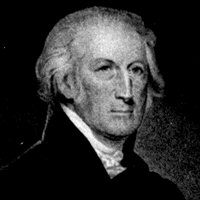 George Clymer George Clymer
Orphaned only one year after his birth in Philadelphia in 1740, George was brought up by a prosperous uncle who provided him with an informal education and eventually made him a partner in his mercantile firm. The business was left to Clymer upon his uncle's death, and he went on to become one of Philadelphia's most influential merchants. Originally attracted to the revolutionary cause as a result of the impact that British economic restrictions had on his business operations, Clymer was one of the first people to call for complete colonial independence. He began taking part in patriotic meetings and was at the head of a committee which brought about the resignation of a British appointed Philadelphia tea consignees in 1773. His strong economic and financial training was of particular help to the revolutionary effort, and he even helped to cover the costs of the war by trading in his own specie for the Continental currency. Clymer was one of the more reserved delegates present at the Continental Congress in 1776, yet he was quite active on committees that dealt with commercial, financial and military matters. On the down side, his house was destroyed by the British in September of 1777, and his wife and children were forced to hide out in the woods nearby. He left politics for a period of time after attending in the Continental Congress, and then returned to serve on the Pennsylvania Legislature from 1784 to 1788. While holding this office, he voiced his opposition to capital punishment, pushed for reforms in the penal code, and represented Pennsylvania at the Constitutional Convention in 1787. Between 1789 and 1791 he represented Pennsylvania in the First Congress. Once he retired, he remained active, working for projects such as the Philadelphia Agricultural Society, the Philadelphia Academy of Fine Art, and the Philadelphia Bank. In 1813 he passed away at the age of seventy-three, and was laid to rest in the Friends Meeting House Cemetery in Trenton, New Jersey. |
Robert married Mary, circa 1797. Her last name is unknown. Robert's father, William, died on 26 September 1797 at the age of 77.
On 16 June 1798 four new companies of infantry were organized in Philadelphia under the command of Captains McEwen, Heysham, Frobisher, and Willing. These were placed in Mcpherson's Blues. The uniform of the Blue's was of navy-blue cloth, pantaloons edged with white, a tight round jacket, edged in the same manner, with red lapels, cuffs, and collar. Robert was commissioned as a Captain of a company of infantry of the Provisional Army of the United States, in Philadelphia, on 18 June 1798 by President John Adams. This commission and the Captain's sword were in the possession of his descendent, Theodore Heysham, see below. Robert was probably involved in the incident below related from the Journal of Elizabeth Drinker,
"September 4 (1798). The Bank of Pennsylvania was this afternoon removed from Philadelphia, where it has lately been robbed of a considerable amount, to the school house in this town, escorted by McPherson's Blues."
According to his descendent, Theodore Heysham, Robert had a commission in the Provisional Army signed by President Adams.
| The Quasi-War & The Provisional Army of the United States
In an effort to resolve differences with France that had accumulated between the two nations since the Treaty of Alliance of 1778, President John Adams dispatched a commission of three men to meet with French Minister of Foreign Affairs Talleyrand in 1797. After many delays the American commissioners were approached by three intermediaries of Talleyrand, who demanded apologies for allusions critical of France made by President Adams and payment of a bribe of several million dollars before official negotiations could proceed. Convinced that further negotiations were hopeless the three commissioners returned to the United States, and President Adams released their dispatches to Congress, substituting X, Y, and Z for the names of Talleyrand's agents. "I will never send another minister to France without assurances that he will be received, respected, and honored, as the representative of a great, free, powerful, and independent nation," Adams declared. The American public was outraged at publication of the dispatches, and Congress enacted a series of measures to raise an army and authorize a Navy Department. It also unilaterally abrogated treaties with France, authorizing privateers and public vessels to attack French ships found competing with American commerce. Between 1798 and 1800 the U.S. Navy captured more than 80 French ships although neither country officially declared war. The force that President Adams raised in 1798 was a provisional army of twenty thousand regular soldiers. George Washington, the ex-President, then 65 years old, was placed in charge of the new force, though he did not think it likely war would actually be required. Alexander Hamilton was appointed first Major General and placed in active supreme command. In November Washington held a conference at Philadelphia with all the general officers when arrangements were made for the complete organization of a provisional army on a war footing. The British delighted in the anti-French uproar in America and moved to assist the United States against a common foe, revolutionary France. President Adams wanted to avoid a major war, confident that had France wanted war it would have responded to American attacks on French ships. Talleyrand feared that limited hostilities with the United States might escalate into a full-scale war and let it be known that he would accept a new American diplomatic representative. Adams nominated a new representative to France despite public and Federalist disappointment that there would be no war, but conceded to Federalist demands and expanded the single nomination into a commission of three. Although the Franco-American negotiations were initially deadlocked, France finally agreed to cancel the Treaty of Alliance of 1778 if the United States dropped financial claims resulting from recent seizures of American merchant shipping. The resulting Convention of 1800 terminated the only formal treaty of alliance of the United States. It would be nearly a century and a half before the United States entered into another formal alliance. With that the Provisional Army was disbanded in 1800, having never fought a battle. It was during this period that the famous American frigates, CONSTITUTION, CONSTELLATION and UNITED STATES were built that would see such successful operations against the British in 1812. |
Watson's "Annals of Philadelphia and Pennsylvania," 1857, has a long tribute to "McPherson's Blues" that mentions Robert's service. Watson himself, as you'll read, was a member of the battalion which is why, I suppose, he uses Robert's surname only, assuming we all will know who he was talking about.
"MACPHERSON'S BLUES" --- For several years after the Revolutionary war, it was much the practice of the times, to bring out in the military displays, those individuals who had seen service, and manifested their patriotism, in that struggle for national independence. They were seen mostly in the grade of officers --- the common soldiers being generally exempt from age, or by their impaired bodily strength. The last remembered exhibition in which the mass of them were so gathered, was the occasion of the La Fayette national visit. It was melancholy, even then, to observe how few could then be thus mustered! [Only one hundred and seven could be got present, at the Bunker Hill Monument.]A view of these facts, causes the present writer sometimes to say facetiously to his friends and former companions in arms, that the next best substitute for Revolutionary men, will be the men of the once celebrated "Macpherson's Blues". These, at the time of their first embodying, in 1794, surpassed all former volunteer array in our city, both for numerical force, and the respectability of the young men enrolled. They were originally formed for the Western or Whisky Insurrection, to serve under General Macpherson, (of the Revolutionary army) and to be attached to General Washington's command. As such, they went forward over the mountains to their place of rendezvous. After their return, they continued to muster and display, and to grow in numbers; when at length came out "the affair of the Chesapeake" [a Britsih frigate fired without provocation upon the American warship CHESAPEAKE], which gave a new impulse, and a new accession of strength. They did not believe that Commodore Barron [CHESAPEAKE's commander] was bound to encounter such unequal odds, with his unprepared armament, and were willing to avenge the national affront themselves. They forthwith offered "their lives and sacred honours" to their country. The consequence was, that the corps soon formed an entire regiment of Infantry, one or two companies of Grenadiers, one of Artillery, and a corps of Cavalry. For array, discipline and exercise, they were the Lions of that day, and "won golden opinions" readily, from all. The writer, himself, then a minor, and brim full of patriotism, joined them about the time of the "Northampton Insurrection" [John Fries rebellion], [ for Insurrections were then rife, with some !] and although not draughted to that expedition, felt as martial as those who "marched up, and then came down again!".
These now, in their turn, though once numbering over their thousand men, are also "receding from the things that be"; and if they were now called to some public fete, to exhibit the remains of their former selves, would be not unlike the few Revolutionary men which preceded them.
Those who remain should, some of these days, make a gathering around some festive board, if not "to note and book their dead", at least to generate brotherhood and fellowship with the few that remain. What vicissitudes have since gone through their ranks, or changed their relative lives ! We begin now to see sundry of them falling into "the sear and yellow leaf" of decay. Some of them, indeed, by sickness, or by the wear and tear of life, expose "sad remnants of themselves". At the same time, others of easier life, still show vigour and strength, even for another war. Of our officers, it is believed that scarcely any remain --- such were McEwen, Hale, Baynton, Willing, Heysham. Our uniform then was blue cloth jackets and pantaloons, the last tight as the skin, the same both for summer and winter; with fur hats covered with bear skins, and adorned with a black cockade and a buck's tail. Our pantaloons, as I remember, were a sad affair for self-discomfiture on a hot summer day ! Strange that none should have been wise enough to suggest their attire in white summer pants ! But so is all knowledge, by degree ! And even now, the military are not wiser, which admit no cover for the face, in the present form of caps !
This great corps having been formed for service, rather than for city display, was allowed to go down, after they had come to the conclusion that no service remained to be performed. They were therefore `non est', when the subsequent call for the second British war came up, under President Madison in 1812.
One ought not to close so military a chapter, without saying a few words for the uniform, so peculiarly American, as is the Hunting Frock or Shirt. THAT is the thing, in which to deck our WHOLE American Militia !! It is a thing to be adopted, as at the head and front of all other expedients to please the militia, by its great economy, and at the same time, to produce such uniformity of appearance, as to make the wearers respect themselves; and by consequence, to give such attention to their army and exercise, as to become efficient soldiers; not inferior to more costly parades of "Volunteers", themselves.
Hunting frocks, of blue, or other coloured, strong muslin, with red or white fringe, could be made in quantities, at $1.50 each, to be worn over the common under dress of citizens; and caps of varnished cotton cloth could be had at half a dollar. Both of these could be readily procured, by every man above the condition of a pauper. Will any consider, will any try it?
In honour of this "American Frock", we are to say, that such was the uniform of the Maryland line under General Smallwood, during the Revolutionary war. His command was formed of the sons of good farmers, from around and about Baltimore. With such dress, they once quartered in Philadelphia, and afterwards fought and won many a battle. Such was, in effect, this Riflemen's garb, under the celebrated General Morgan, during all of that war. Such, too, was the common scouting dress of all those Kentuckians, Wood Rangers, and Western Pioneers, who won all our Western country from the Indian tribes. Has no one a Hunting song for the Hunting frock? It has incident enough, in itself and associations, for poetry and romance !"
Per the following, Robert was still a member of the Adam's administration at the end of 1798.
31 December 1798. Abstract: "James, and Uriah Tracy., Phila. Deed of cession to the U.S. of Connecticut's western land. Dec. 31, 1798. 3 p. Witnessed by Samuel A. Otis [Secretary] and Robert Heysham [Principal Clerk]." - from the National Archives, Miscellaneous Papers of the Continental Congress, Cession of Land.Note too that at least one reference shows that Robert's son, Robert Jr., was born in New York.
In the 1800 census . . . Was a census taken in Washington, D.C? Census records for Virginia were lost, so if Robert lived across the river in Alexandria, we'd have no way of knowing.
Congress passed a law on 16 June 1790 that provided
""that all offices attached to the seat of government should be removed from this district [Philadelphia] on the first day of December, in the year one thousand eight hundred, by the respective holders," and declared that the necessary expenses of such removal should be defrayed out of the duties on imports and tonnage." - from "Records of the Columbia Historical Soceity, Washington D.C."By November 1800 the Congress had moved to the new Federal City on the Potomac river.
""An account of Payments made at the Treasury for the removal of the Officers and Clerks of the several Executive Departments to the seat of Government; also the expenses attending the removal of papers, books &c . . .
Secretary of the Senate's Office
Samuel A. Otis, Secretary, 849.31
Robert Heysham, Principal Clerk, 345
John Dempsie, Clerk, 352
James Mathers, Doorkeeper to the Senate
for removing office papers, 136.19
Ditto, for removing his family, 340
James Mathers, Jr., Asst. Doorkeeper, 131.19" - from "Records of the Columbia Historical Soceity, Washington D.C."
The Federalists lost their hold on power when John Adams was defeated for re-election by Thomas Jefferson, a Republican. In a quirk of the Electoral College Jefferson had been trapped in a tie with Aaron Burr, his supposed Vice Presidental running mate. In a deal made with Federalist's electors Jefferson agreed, among other things, not to make sweeping cuts in the Federalist workforce then in government, so Robert's job was safe. However, in 1803 John Quincy Adams, a new Senator, wrote his father that Robert's boss, Samuel Otis, "is much alarmed at the prospect of being removed from office." Otis nonetheless held his post until his death in 1814.
Robert Heysham esquire is noted in 1,136 official documents from 10 September 1784 to as late as 11 February 1801. - from "Papers of the War Department, 1784-1800."
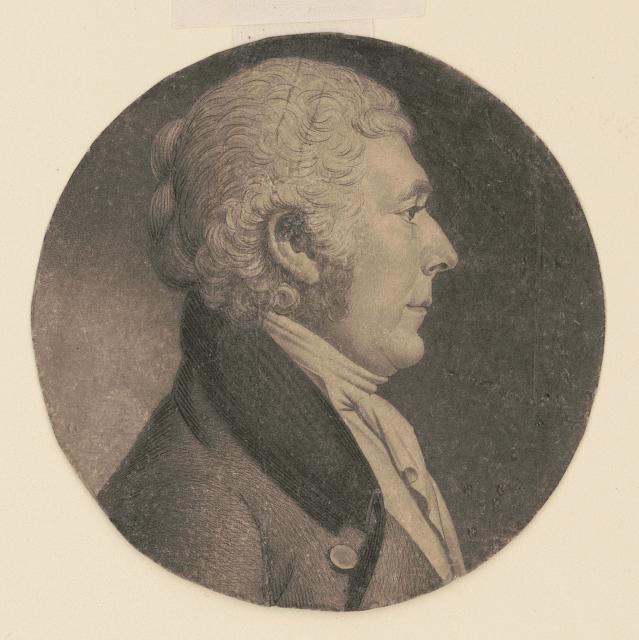 A portrait of Robert Heysham, a head & shoulders view, from the right profile, shown to the left, was created in Philadelphia in 1802 by Charles Balthazar Julien Fevret de Saint-Memin. It is in the Library of Congress, where this image was obtained. Memin was a portraitist and museum director. He fled France during the revolution, and worked as a portrait engraver in the United States in the early 19th century. He created portraits from life of George Washington, Thomas Jefferson, and others.
A portrait of Robert Heysham, a head & shoulders view, from the right profile, shown to the left, was created in Philadelphia in 1802 by Charles Balthazar Julien Fevret de Saint-Memin. It is in the Library of Congress, where this image was obtained. Memin was a portraitist and museum director. He fled France during the revolution, and worked as a portrait engraver in the United States in the early 19th century. He created portraits from life of George Washington, Thomas Jefferson, and others.
Robert followed his Senate job to Washington, D.C. in 1800 and appears to have held it, as Samuel Otis did, into 1803. The following citation is from a book of heraldry for American families. Robert, as a descendent of Gyles Heysham of Lancaster, was, as we know, authorized to assume the Heysham arms. The reference includes "the name of the first of the family in America, the date of his arrival and place of settlement, and, in the majority of instances, the town or country whence he came."
Heysham, Washington, D.C.I think what this citation is trying to say is that in 1803 the Heysham family resided in Washington D.C., and that William Heysham, Robert's father, was the first of the line to live in America. It also seems to imply that William came from London, but that may be a confusion with the origin of the arms, those of another William Heysham, the merchant of London.
William Heysham, 1803.
(London.)
Gules, an anchor or on a chief of the
last three torteaux
- from "Crozier's General Armory: A register of American families entitled to wear coat armor" by William Armstron Crozier, 1904
Robert became the Deputy Naval Officer [of Customs] for the port of Philadelphia under General William McPherson, his old commander. McPherson was the port's Naval Officer from 1793 to 1813. This was another kind of "spoils system" in which Robert's excellent Federalist connections did him some good.
The Naval Office appears to have been a Treasury Department position connected with the enforcement of trade regulations. The Deputy Naval Officer's responsibilities would be to keep records of imports and exports, make lists of vessels entering and clearing the harbor, and examine certificates of bond and registration. He would be responsible to the Naval Officer, who was his old commander, William McPherson. He might also be a collector of customs, collecting duties on imports and exports. It would have taken some connections to get this lucrative government position. I don't know if this was true at the time, but later jobs such as this were part of the "spoils" system with which polticians rewarded their supporters. It would seem also a job ripe for fraud. Per Banta, Robert held this position "under McPherson's appointment."
In the 1810 census of North Mulberry Ward, Philadelphia, Pennsylvania as Robt Heysham [Heyshal in Ancestry.com]. Remember that Robert's father, William, had lived on Mulberry street in North Mulberry ward. Also note that Mulberry and Arch streets are the same road. There is quite bit more information on this census form than normally is shown. Robert lived in between two empty houses, one of them unfinished. His address was garbled, but was probably 275 [107/323 was his father's old address] North Mulberry on the north west corner of 8th street [?]. The neighborhood was eclectic and included an accountant, a sugar refiner, a doctor of physic, a bricklayer, a mantua maker, a merchant, and a seamstress. He was described as a Gent. [Gentleman]. The census listed 13 people in his household, 2 boys under 10, 2 boys 10 to 15, 1 16 to 25, and one man 45 or over. There were 2 girls under 10, 2 girls who were between 16 and 25, 1 26 to 44, and one 45 or older. There was one other in the category "all other free persons," probably a servant.
In March 1812 Robert added his signature to two documents made by Thomas Wilson, the Deputy Collector of the Port of Philadelphia. Each dealt with a list of crew members provided by Peter Fosse, Master of the brig JANE, of Philadelphia. Another document, in December 1812, dealt with the certification that Abraham Williams, master of the ship ARIADNE, had permission to sail with a new crew.
In 1816 Robert witnessed the will of Mary Craig, Philadelphia, Widow of William Craig of said city. Merchant. Signed March 23, 1816. Proved: February 26, 1822. 7.448. Mentions estate of Richard Jones. Sister: Elizabeth Johns who now lives with me. Nephew: William J. Jones. All residue to my daughter: Mary Wharton. Son: William Craig. Exec: Son: William. Son in law: John Wharton. Wit: Lowry W. Price, Robert Heysham, George Hawkins. Robert Smith of said city, Merchant, affd. Benjamin Tilghman renounced.
In 1817 Robert was still the Deputy Naval Officer of the port - From a list of persons composing the crew of the ship PHOENIX of Philadelphia whereof is Master Wm. McKibbin, bound for Liverpool and Canton, April 10, 1817. Wm. McKibbin, Phila., Master (5 crew member mentioned as deserted--tmck). Sworn to April 10, 1817 by Wm. McKibbon, before A Epplee D. Coll'r. Rob. Heysham D.N. off (Deputy Naval Officer, see above), B. Thomas Inspt. certified crew on return May 4, 1817. From Maritime Records: Alphabetical Masters and Crews: 1798-1880_. 108 Vols. Presented by the Pennsylvania Historical Survey. December 5, 1941.
In the 1820 census of the Northern Liberties Ward 3, Philadelphia, Pennsylvania as Robert Heisham [Hersham in Ancestry.com]. In the household were 2 boys who were 0 to 10 years old, William & Edward, 1 who was 10 to 16, John, 1 16 to 18, ?, 2 who were 16 to 26, Robert Jr. & Alexander Hamilton, and one man over 45, Robert. Of women, 1 was 0 to 10, Frances, 1 was 10 to 16, Mary, one was 16 to 26, Margarita, and another was 26 to 45, Mary. Two members of the family were engaged in commerce; this was probably Roberts Sr. and Jr. There was also a free colored woman, aged 14 to 26, in the house.
Robert died on 14 November 1822 in his 63rd year.
"Died: on Nov 14, after four days illness, Robt Heysham, in his 63d yr; late Deputy Naval Officer for the port of Phil; also srv'd as an ofcr in the Rev war." - from the "National Intelligencer Newspaper Abstracts: 1821-1823" by Joan Marie DixonHe was buried at Christ Church on 15 November 1822. The Will of Robert Heysham of Philadelphia, Pennsylvania, dated 4 July 4 1812, was proved on 16 December 1822.
"Estate to my wife: Mary, persuaded that she will do what I wish should be done unto the children. Exec: Wife: Mary Heysham. Thomas Hale (of Philadelphia), Merchant, Robert Heysham of said city, affd."
The Philadelphia Directory & Stranger's Guide for 1825 listed Mary Heysham, widow (presumably of Robert), with a Drygood store at 48 North 6th street. There is also a Mary Heysham listed as living at 230 South 2nd street. Her son, Robert, was listed as a "naval clerk at the custom house."
In the 1830 census . . .
When Mary's son, John, died in 1831, his mother was said to be in Philadelphia "in indigent circumstances."
Robert and Mary's children were,
(22) Margarita Heysham (c1798)
(22) Robert Heysham (1798)
(22) Alexander Hamilton Heysham (c1804)
(22) Mary Heysham (c1800)
(22) John Gibbon Heysham (1803)
(22) Ann Dorothy Heysham (1811)
(22) Ann Sayre Heysham (1814)
(22) William Sayre Heysham (1816)
(22) Edward Heysham (1818)
(22) Fannie [Frances] Heysham (1825)
According to Theodore Banta, she died in October 1824, in Philadelphia. unmarried. Margaretta Heysham, born in about 1806, died on 24 September 1824, at the age of 18, in Philadelphia and wa buried at Christ Church - from "Philadelphia, Pennsylvania, Death Certificates Index, 1803-1915."
(22) Robert Heysham (1798)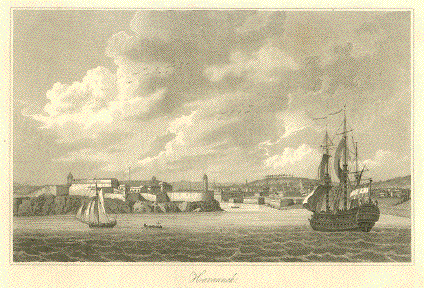 The son of Robert Heysham Sr., Robert Jr. was born on 31 October 1798 in Philadelphia. Note that the 1860 census indicates Robert was born in New Jersey and an almanac of Treasury employees says it was New York. The latter makes a lot of sense if we assume Robert Heysham Sr's family had joined him while he was employed in the Senate.
The son of Robert Heysham Sr., Robert Jr. was born on 31 October 1798 in Philadelphia. Note that the 1860 census indicates Robert was born in New Jersey and an almanac of Treasury employees says it was New York. The latter makes a lot of sense if we assume Robert Heysham Sr's family had joined him while he was employed in the Senate.
Robt Heysham Jr., a 25 year old gentleman, was listed on the manifest of the brig PHILDELPHIA, of 110 tons burthen, out of Havana, Cuba which arrived in the city of Philadelphia on 1 March 1821. An Alexander Lopez, also a 25 year old gentleman of the USA, was his only companion. The ship's master was listed as Peleg Hall. The owners were Peleg Hall and [?] Callaghan - from Philadelphia Passenger Lists, 1800-1945. What Robert was doing in Havana is not indicated. The engraving to the right shows the port of Havana in 1821. At this time Cuba was still a colony of Spain, though revolution was sweeping through South and Central America. Trade between Cuba and America, especially American flour, was brisk.
| Peleg Hall
I have a Peleg Hall, Quaker, of the Hardwick and Mendham Monthly Meeting of Warren & Morris counties, New Jersey. His wife, Hannah H. [Lundy?], died on 22 October 1834. A Peleg Hall was a member of the State Society of the Cincinnati of Pennsylvania at the time of the unveiling of the Washington monument. As late as 1830 Peleg Hall was listed as the owner of the PHILADELPHIA, a ship that, at the time, was sailing between St. Eustatius, Netherland Attiles & St Thomas, Virgin Islands and Philadelphia under Master Epharim Hall. |
Robert Jr. apparently was in the Customs Office as early as 1822. This could be Robert Sr., but I'd assume he'd have a higher position than clerk to the Naval Officer at that time in his life.
1822. "Robert Heysham . . . Clerk to naval officer . . . 1,000.00 . . . Nov. 19, 1822 [date of appointment]" - from "Congressional Serial Set" of 1874
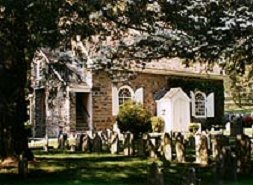 Robert's father died on 14 [16] November 1822. On 1 May 1823 he married Anne Stewart (Stuart) in the Old St. David's Church in Radnor township, Delaware county, Pennsylvania, left. The church was built in 1715. Radnor had originally been part of the "Welsh Tract," given to the Welsh settlers by William Penn as a separate 'Barony,' and St. David's was a Welsh church. Anne was born in 1803, the daughter of Charles Stewart and Margaret Warner. Note that Anne's eldest sister married J.M. Besson, explaining the name of her grandson, below. The marriage certificate was signed by Bishop William White, the first Episcopal Bishop of Pennsylvania. His house on Walnut street has been preserved.
Robert's father died on 14 [16] November 1822. On 1 May 1823 he married Anne Stewart (Stuart) in the Old St. David's Church in Radnor township, Delaware county, Pennsylvania, left. The church was built in 1715. Radnor had originally been part of the "Welsh Tract," given to the Welsh settlers by William Penn as a separate 'Barony,' and St. David's was a Welsh church. Anne was born in 1803, the daughter of Charles Stewart and Margaret Warner. Note that Anne's eldest sister married J.M. Besson, explaining the name of her grandson, below. The marriage certificate was signed by Bishop William White, the first Episcopal Bishop of Pennsylvania. His house on Walnut street has been preserved.
Robert Heysham was amongst the subscribers of the Musical Fund Society of Philadelphia in 1823.
The following is our Robert, as clerk in the Customs office.
1825. "Executive. Treasury Department. Customs, Delaware.Note that Robert was employed by the nearby Delaware unit, not that of Pennsylvania.
Names and Offices
Jacob Zebley, Inspector,
Williams Jones, Naval Officer,
John D. George, Dep-Naval Officer,
Robert Hesham, Clerk" - from "A Register of Civil, Military, and Naval, in the Service of the United States on the 30th of September, 1825"
The following indicates that while Robert Heysham was deputy Naval Officer (under Samuel Clarke) and clerk in the customs house in Philadelphia, earning $750.00 per annum, he was born in New York.
"Treasury Department.The book says of the custom house officers, that "[t]he principal officer employed in the collection of the duties on imports and Tonnage, is the Collector, to whom the Naval officer is at once and aid and a check. The Surveyor superintends and directs the inferior officers of the Customs; and all three are appointed by the President and Senate. . . ."
. . .
National Calendar . . . 1824
Officers of the Customs . . . Pennsylvania
. . .
Rob't Heysham, dep. Naval Officer & Clk. . . . Philadelphia . . . N.Y. 750 00" - from "A National Calendar for " by Peter Force
The Philadelphia Directory & Stranger's Guide for 1825 lists a Robert Heysham, Naval Clerk at the Custom, living at 13 Wood street. Wood street is part of the original city and intersects 2nd and 3rd streets in the city center.
In 1826 Robert was deposed before the aldermen of the city of Philadelphia. The contention was that the goods of a merchant, Edward Thomson, had been removed from the wharves of Philadelphia without the proper duty being paid. A large number of people were deposed. The interrogations were performed at the request of the Secretary of the Treasury.
Further questions along these lines brought the same general answers. Either Robert knew nothing or he was smart enough not to implicate his bosses. From America State Papers [Finance: Volume 5]: Index to Finance."Interrogation of Robert Heysham, and his answers
Question 1. Have you any knowledge, if so, state it, of the illegal removal of teas from the wharves to places other than the stores in which they should have been deposited, of the state of these stores, and of the surreptitious removal of teas from them?
Answer. My station, as clerk of the Naval Officer, confines my attention exclusively to the custom-house; I have no opportunity of knowing of the removal of merchandize from the wharves, nor of the state or condition of the stores in which the same may be intended to be deposited. Of the surreptitious removal of teas I know nothing.
Question 2. Do you know of the existence of any collusion between any of the officers of the custom-house and Edward Thomson, or of any connexion or close intimacy with him, or any other facts, indications, or appearances, pointing to just suspious on this head? If you do, state minutely the extent of your knowledge.
Answer. I do not know of any collusion, close intimacy, or connextion between Edward Thomson and any of the officers of the customs, nor am I acquainted with any facts, indications, or appearances which could in any way lead to just suspicious of improper and illicit connextions."
In the 1830 Census Index for Philadelphia county, Pennsylvania, as Robert Heysham [Hysham in Ancestry.com]. He was living in Spring Garden township, an early suburb of the city. In the census was one boy under 5, Charles Stewart, 1 who was 5 to 10 years old, Robert Jr., and a man 30 to 40 years old, Robert Sr. Also living there were 1 girl under five, Elizabeth Greenleafe, and two women 20 to 30 years old, probably Robert's wife, Anne, and a sister, Fannie?, or sister-in-law.
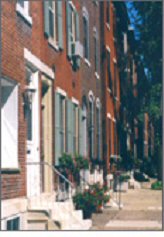 Spring Garden Spring Garden
The historic Spring Garden neighborhood of Philadelphia was one of the earliest suburbs of the city, being built just outside the original limits of the city proper. While it is now characterized by extensive manufacturing establishments, including the Baldwin Locomotive Works and Powers & Weightman's chemical laboratory, it was once one of the most pleasant suburbs of Philadelphia. It consisted of large single family townhomes. |
The following are records of Robert's service in the Customs Service.
1832. "John Pemberton, naval officer . . .
. . .
Robert Heysham, clerk . . . 660 [Pay per Annum] . . . - . . . 660" - from "House Document" of 1832
1835. "Customs
. . . . John Pemberton, Nav. Officer . . . Philadelphia . . . Md . . . 3000
. . .
Robert Heysham . . . Clerk . . . Philadelphia . . . N.J. . . . 840" - from "Official Register of the United States" of 1835
1837. "Principal Officers of the General Government
Names and Offices . . . Where Employed . . . Where Born . . . Salary
President of the United States Andrew Jackson, of Tennessee . . . $25,000 per annum
. . .
Customs
. . . . John Pemberton, Naval Officer . . . Philadelphia . . . Maryland . . .3000
. . .
Robert Heysham, clerk . . . Philadelphia . . . N. Jersey . . . 840" - from "The New Jersey Register" of 1837 by Joseph Potts
Anne Stewart Heysham died on 10 May 1838. She was only 35 years old. A contrary indication is that Robert's wife died and was buried at the Radnor church on 16 March 1858. She being then 54 years old. However, Robert, as you'll see below, was living alone at the time of the 1850 census and his children, Robert, Theodore and Margaret were living together on a farm. Below is the receipt from the funeral home for Anne's funeral.
"1838 March . . .Two of Philadelphia's oldest undertakers were Andrew J. Bair and Son, and R.R. Bringhurst and Company, at 1924 Arch Street. Both firms were founded in 1822 and merged in 1972. Bringhurst was Philadelphia's "carriage trade" undertaker, handing the funerals of city notables.
18th Robt Heyshem to Mahogany Coffin for Wife 14 (Paid)
Hearse & 6 Carriages from Carter 16 (Paid)" - from "R.R. Bringhurst and Co. Records" in "Pennsylvania and New Jersey, Church and Town Records, 1708-1985"
On three separate occassion Robert attempted to get the Congress to address his claim for an "arrears of pay as clerk in naval office, Philadelphia." This was presented as a memorial in the first session of the House of Representatives in the 26th Congress, which met in 1839/40, and during sessions two and three of the 27th Congress, which took place from 1841 to 1843.
I may have misread the claims above.
"To warrants paid in the 3d quarter 1839, viz:
No. On account of the civil department.
. . .
[8]1 Robert Heysham . . . [blank]"
"To warrants paid on account of the civil department;
Outstanding on the 20th July, 1839, viz:
No. Brought Forward
. . .
2081 Robert Heysham . . . 340.00" - from "Public Document" by The Senate of the United States.Second Session of the Twenty-Sixth Congress. December 7, 1840
In the 1840 census . . .
In the Philadelphia city Directory of 1840 as,
"Heysham, Robert, clerk, Customhouse.
Heysham, Wm. Sayre, N W 5th & Commerce."
On February 1840 "Mr. Sergeant presented a memorial of Robert Heysham, a clerk in the office of the naval officer of the customs for the port of Philadelphia, setting forth that $15,000 was appropriated at the last session of Congress, for arrearages of pay of the clerks of the custom-house at Philadelphia, and that the same has been apportioned to the exclusion of himself, and praying that the sum of $1,000 may be appropriated to make his salary, from the year 1832 to 1837, inclusive, equal to what he received in the year 1838." From the "Journal of the House of Representatives of the United States," 1839-1840 6 February 1840.
- On 24 April 1840 a the Committee of Ways and Means was discharged from further consideration of this request. That is, it was tabled.
- On 23 December 1841 this request was again submitted.
- On 12 December 1842 it was brought up again. It is unclear what happened after this.
In the 1850 census of High Street Ward, Philadelphia, Pennsylvania as Robert Heysham, a 50 year old working in the Office of Customs, born in Pennsylvania. He was living alone as a boarder in the house of Charles M. Griskey, a merchant. This was in the old city center.
| High Street Ward
This ward of the city of Philadelphia was part of the old city. It extended within a line from the Delaware river, thence by Mulberry Street to Fourth Street, thence by the same to High Street, thence by the same to the river Delaware, and thence by the said river to Mulberry Street. |
Robert was a commissioner, and probably an initial stock owning member, of a turnpike company.
1853. "An Act to incorporate the Plymouth and Upper Dublin Turnpike Road company . . .This was a toll-road that continued in operation through at least 1895.
Section 1. Be it enacted by the Senate and House of Representatives of the Commonwealth of Pennsylvania in General Assembly met, and it is hereby enacted by the authority of the same That Alan W. Cranston, . . . Robert Heysham, . . . and Silas Shoemaker, or any seven of them, are hereby appointed commissioners, to open books, receive subscriptions, and organize a company by the name, style and title of "The Plymouth and Upper Dublin Turnpike Road company," with power to locate and construct a turnpike road, commencing at Plymouth meeting, in Montgomery county, and continuing on or near the bed of the road, by the best and most practicable route, by way of the Broad-axe to the Bethlehem turnpike road, so called, at the commencement of the Lewisville and Prospectville turnpike road, in the township of Upper Dublin . . ." - from "Law Enacted in the General Assembly of the Commonwealth"
According to the account of Theodore Heysham, below, Robert retired to the farm of his son, Robert, in Plymouth township, Montgomery county, Pennsylvania.
He later moved in with his other son, Charles. In the 1860 census of Delaware county, Pennsylvania, Robert Heysham was living with his second son, Charles Stewart Heysham, a physician aged 35 with real property valued at $5000 and personal property valued at $1000. Robert was listed as being 60 years old with real property valued at $9000. His birthplace was shown as New Jersey (?). Also at this address were Charles' wife, Margaret, 28, and a daughter Elizabeth, 6.
At the same address were two farmer laborers, Johan Shane and Ge. Doum, and a domestic, Sallie Hoopes. Note that Sallie Hoopes later married a son of Robert's (was this a love-match growing out of their proximity or a forced marriage because Robert Jr. got her in trouble?).
Robert died on 2 December 1867 in Radnor, Pennsylvaniai and was buried in the Old St. David's Episcopal Church burying ground - from an alphabetical list of internments in Radnor Church burial ground, 1716-1906, "The History of Old St. David's Church, Radnor, in Delaware County, Pennsylvania" prepared at the request of the Historical Society of Delaware County Pennsylvania, 1907.
His children were,
(23) Robert Heysham (1824)
(23) Dr. Charles Stewart Heysham (1825)
(23) Elizabeth Greenleafe Heysham (1829)
(23) Theodore F. Heysham (1834)
(23) Margaret Heysham (1838)
He was born on 24 February 1824 in Philadelphia. He was said to be "delicate in youth" and therefore sought a home in the healthier atmosphere of the country. A (gentleman?) farmer living in Conshohocken Pike, near Cold Point, Montgomery county, Pennsylvania. This is just northwest of Philadelphia in Plymouth township, which was consistent with his father's retirement, above.
On 19 April 1840 Robert Heysham took [first?] communion in the Trinity Lutheran church of Germantown, Pennsylvania.
In the 1850 census of Plymouth township, Montgomery county, Pennsylvania as Robert Heysham, a 26 year old farmer. Living with him were his brother, Theodore, 14, and sister, Margaret, 12.
In the 1860 census of Plymouth township as Robert Heysham [Hushaw in Ancestry.com, and I admit it looks more like Hesshem], a 36 year old farmer, living in the house of William Nobles. He was born in "Philadelphia city."
He married Sarah Elizabeth Hoopes in on 27 September 1860. She was born in February 1840. In the 1860 census a Sallie Hoopes was listed as a domestic living in the house of Charles S. Heysham, Robert's brother. Perhaps this was her comely young daughter, or did Robert marry the maid?
| Norristown, Montgomery county
Montgomery county was separated from Philadelphia County in 1784, giving its citizens their own government. Norristown is located on the Schuylkill River and while settled early in the colonies history, was not incorporated until 1812. |
Robert remained in Conshohocken Pike from 1850 until 1868 when he moved to Norristown, residing on the south side of Penn street, between Green and Arch. He took up the study of the law with George N. Corson, but never sought to enter the profession.
In the 1870 census for Norristown, Montgomery county, Pennsylvana as Robert Heysham, a 45 year old Real Estate Agent. His real property was worth $8,000 and he had personal property worth $3,000. Living with him were his wife, Sarah, 31, and chidren, Stewart, 8, and Theodore, 6. All were born in Pennsylvania.
In 1875 he moved from Penn street to No. 225 Jacoby street where he resided until his death. His descendents were living there as late as 1940.
| 225 Jacoby Street
|
In the 1880 Federal census of the 4th Ward, Norristown, Montgomery County, Pennsylvania as Robert Heysham, a 55 year old Real Estate Broker. Living with him were his wife, Sarah, 41, and sons, Stewart, 19, a law student, Theodore, 16, a farm hand, and Horace, 7.
A court case, Robert Heysham versus Ambrose Dettre, went to the Pennsylvania Supreme court in 1879. Defendent purchased a house of plaintiff. Before the delivery of possession plaintiff claimed the right to remove the heater and gas-fixtures, which defendent denied. Plaintiff threatened to remove them, when defendent gave his note for the value, making it payable to plaintiff alone . . . The verdict was for the plaintiff. On appeal for the judgement was affirmed. - from "Pennsylvania State Reports"
Robert was a Democrat in his politics and a member of the Independent Order of Odd Fellows. He was a member of the association formed to celebrate the centennial of Montgomery county in 1884. From Bean's 1884 History of Montgomery county, Pennsylvania, The Centennial Fair: Exhibit Classes XX, Oil Paintings:
Heysham, Robert, Norristown.Were those the arms of William Heysham, merchant of London, or the older arms of Benedict Gernet that the English family claimed as their own? Other items shown at the fair by Robert included,
Photograph of old Norman coat-of-arms of Heysham family, dated 1500 [sic].
Heysham, Robert, Norristown.There was also a China Cup and Saucer, also over 100 years old, displayed.
Portrait of Ann Stuart [Robert's mother], over 70 years old.
Profile picture of Major [?] William Heysham, 100 years old.
| The 1876 Centennial Fair
Philadelphia hosted the 100th birthday party for the United States in 1876. It was opened by President Grant on 10 May 1876 on a 450 acre tract of Faimount Park, across the river and northwest of the city. The Centennial Exhibition was viewed as a place to showcase the United States' recovery from the devastating Civil War. Fifty nations were represented in the exhibits and a young America compared its skills with those of long-established nations and found they stacked up better than anyone had expected. 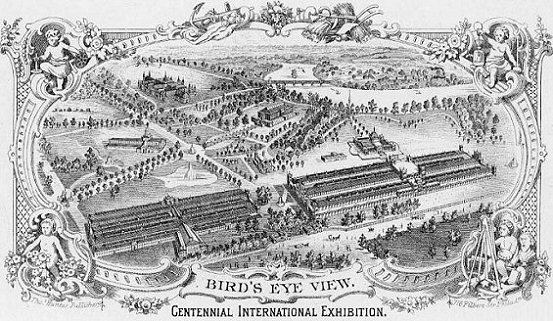 The centennial fair is recreated today at the Smithsonian museum's Arts and Industry's building, on the mall in Washington D.C. The bird's-eye view above of the Centennial International Exhibition shows the locations of the five major buildings (clockwise from top left): Agricultural Hall, Horticultural Hall, Art Gallery, Main Building, and Machinery Hall. The Schuylkill river is at the top. Only the major buildings are shown in this view, the minor ones being omitted to reduce clutter. |
Robert died on 26 May 1892 in Norristown, Pennsylvania and was buried in the Montgomery cemetery.
In the 1900 census of Norristown was Robert's widow, Sallie E., a 60 year old [February 1840] widow. Living with her were his children, Theodore, a 36 year old [January 1864] minister of the gospel, and Horace B., a 26 year old [November 1873] physician.
In the 1910 census Sarah E. Heysham, 70, was living in the 4th Ward, Norristown borough, Montgomery county, Pennsylvania. Living with her were her son, Theodore, 46, Horace B., 36, grand-daughter, Anna S., 8, and grandson, Theodore Jr., 6. Sarah died in 1915 and was buried at the Montgomery cemetary in Norristown.
Robert's children were,
(24) Dr. Stewart C. Heysham (1862)
(24) The Reverend Theodore Heysham (1864)
(24) Dr. Horace Besson Heysham (1873)
The first son of Robert and Sarah Heysham, he was born on 18 March 1862 in Cold Point, Montgomery county, Pennsylvania. He was educated in the public schools in Norristown. In the 1870 census for Norristown, Montgomery county, Pennsylvana as Stewart Heysham, 8. At the age of 16 he began to work at the drug store of Atwood Yeakle. He had intended to study pharmacy, but instead entered the office of Doctor J.K. Weaver and devoted himself to the study of medicine.
In the 1880 Federal census he is listed as a law student [he was 18 years old], living at home with his father, Robert Heysham. He became, however, a medical doctor [the line from the movie "Animal House" seems appropriate: "Pre-Law, Pre-Med? What's the difference?!"]. The census appears to have been in error. He graduated Iron Jefferson Medical College, Philadelphia, in 1882, at the youthful age of 20.
On 7 August 1881 he married Lidie [Lydie] Adle. That seems awfully young, he was only 19. They had one child, Marion.
Dr. Heysham practiced first at Port Kennedy and later removed to Lansdale, where he opened a drug store in connection with his practice. After a short but successful career, he died of an attack of typhoid fever on 25 November 1884, only 23 years old, in Norristown. Doctor Stewart C. Heysham, 23, was buried on 29 November 1884 at St. John's Episcopal church.
| Cold Point Village
Early settlers to this part of southeastern Pennsylvania, near Norristown, were drawn by the area's rich soil and limestone deposits. The Corson limestone quarry, established in 1843, is still operating and is the oldest continually worked lime quarry in the nation. The architecture of the village reflects the English-Welsh heritage of the builders and the raw materials found close at hand. Houses are predominately two and a half story rubble stone single-family dwellings, stuccoed, with gabled roofs, some exhibiting Greek Revival and Gothic detailing. At the time of the nomination of the village to the National Register of Historic Places, the village had 90 structures. These included more than 90 percent of the buildings that appeared on an 1877 atlas. |
Mrs. Lida Heysham, 23, married George W. Righter, of Washington D.C., 29, on 12 October 1887 in Norristown.
In the 1900 census of Ward 32, Philadelphia, Pennsylvania Lidie, 35 [November 1864]. She was married to George W. Righter. Also living with them was Marion E. Heysham, George's step-daughter, 17 [August 1882].
Stewart's only child was Marion.
(25) Marion Estelle Heysham (1882)Marion Estelle Heysham, the daughter of S.C. and Lidie M. Heysham, was born on 2 August 1882, and baptized on 28 January 1883 at St. John's Episcopal Church in Norristown, Pennsylvania. In the 1900 census of Ward 32, Philadelphia, Pennsylvania as Marion E. Heysham, 17 [August 1882]. She was living with her mother, Lidie, 35 [November 1864], and her husband, George W. Righter.
(24) The Reverend Theodore Heysham (1864)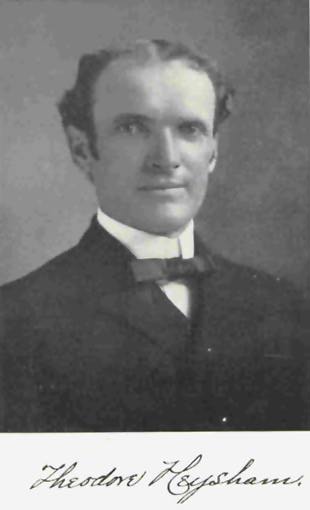 The second son of Robert and Sarah Elizabeth Heysham, he was born on 14 January 1864 [1865 per "Comly Family in America"] near Cold Point village, Plymouth township, Montgomery county, Pennsylvania. While still young his parents moved to Norristown where he was educated in the public schools, first at Sandy street school, and later at Oak street. In the 1870 census for Norristown, Montgomery county, Pennsylvana as Theodore Heysham, 6. On account of his health he did not remain in the high school to graduate, but went into the country, remaining there several years. In the winter of 1886 he joined the Lower Providence Baptist church. Relieving himself called to breach the gospel, he entered on a course of preparative study.
The second son of Robert and Sarah Elizabeth Heysham, he was born on 14 January 1864 [1865 per "Comly Family in America"] near Cold Point village, Plymouth township, Montgomery county, Pennsylvania. While still young his parents moved to Norristown where he was educated in the public schools, first at Sandy street school, and later at Oak street. In the 1870 census for Norristown, Montgomery county, Pennsylvana as Theodore Heysham, 6. On account of his health he did not remain in the high school to graduate, but went into the country, remaining there several years. In the winter of 1886 he joined the Lower Providence Baptist church. Relieving himself called to breach the gospel, he entered on a course of preparative study.
He is in the 1880 Federal census as the son of Robert. He is 16 years old and listed as a Farm hand (a part time avocation or working on his father's Norristown home?). In 1886 he joined the Lower Providence Baptist church and received the calling to become a minister. In 1884 his older brother, Stewart, died.
In the spring of 1887 he entered the National School of Elocution and Oratory in Philadelphia. Later that year he began to attend the Bucknell Academy at Lewisburg, a prepatory school for Bucknell University. After a three years' course of study he graduated with honor in 1890. While at that institution he won two prizes, the David P. Leas prize for the best declamation and the William E. Martin prize for the best oration at commencement. He was also instrumental in forming the Adelphia Literary Society, and was one of its presidents.
He attended Bucknell University from 1890 to 1892. He was a member of the football team, of the Euepia Literary Society, the Young Men's Christian Association, and the Phi Gamma Delta fraternity. In the freshman year he won the William C. Gretzinger prize for the best declamation, and the C. L. William prize for the best essay.
| Bucknell University
In the 1890's the College offered three degree programs, the Classical Program leading to the Bachelor of Arts (A.B.) degree, the Scientific Program leading to the Bachelor of Science, and the Philosophical Program leading to the Bachelor of Philosophy. |
In 1892 Theodore's father died and, in consequence, to be closer to home, he entered the junior class of the University of Pennsylvania. In a Directory of Norristown for the years 1888-1893, he was listed as a student, living at his father's home on 225 East Jacoby.
At the University of Pennsylvania he won the second prize for oratory in the junior year, and was elected a member of the honorary fraternity, Phi Beta Kappa, in the senior year. He was also a member of the Zelesophic Society, of the Red and Blue staff, and was one of the three representatives of the University of Pennsylvania in the first intercollegiate debate with Cornell at Ithaca in 1894, in which the decision was given to the University of Pennsylvania. He was also Phi Gamma Delta and Pi Gamma Mu.
He received an A.B. degree from the University of Pennsylvania in June, 1894. In the fall of that year he entered Crozer Theological Seminary, near Chester, Pennsylvania. He also continued to work in the Department of Philosophy at the University of Pennsylvania. In June 1897 he graduated with honor from Crozer and was one of the speakers at commencement. That summer he was ordained a Minister in the Lower Providence Baptist church.
| Crozer Theological Seminary
The Reverend Martin Luther King Jr. was a student from 1948 to 1951. |
He received his Ph.D. in Philosophy from the University of Pennsylvania in June 1898. His doctoral dissertation was "St. Augustine and His Philosophy -- Especially Freedom of Will." He was subsequently a Pastor at Wayne, Germantown, Swarthmore and Philadelphia. On 10 September 1899 he became the pastor of the First Baptist Church of Bridgeport, Pennsylvania, where he remained for 5 years.
In the 1900 census of Norristown as Theodore Heysham, a 36 year old [January 1864] minister of the gospel. He was living with his mother, Sallie E. Heysham, a 60 year old [February 1840] widow, and his brother, Horace B., a 26 year old [November 1873] physician.
On 24 October 1900 he married Ella May Reese in the Lower Providence Baptist Church. She was born near Trooper, Montgomery county, Pennsylvania on 11 July 1873, the daughter of William Johnson Reese of West Norristown township and Anna Rebecca Harding - from the "Comly family in America." Ella's grandfather had been a Reverend minister.
In addition to his pastorate, he was a member of the Philadelphia Conference of Baptist Ministers, and read several papers before it. He was a member of the North Philadelphia Baptist Association and of the Baptist Ministerial Union of Pennsylvania and was its first vice-president from 1903 to 1904. He was a member of Charity Lodge, No. 190, Free and Accepted Masons, of Norristown Chapter, No. 190, Royal Arch Masons, and of Hutchinson Commandery, No. 32, Knights Templar. He organized the Citizens' Committee, which took action to put a stop to the outrages committed by the so-called "Shirt-Waist Gang," of Bridgeport, in January, 1904 [what this was is unknown]. He was connected with the Alumni Societies of Bucknell University, the University of Pennsylvania and Crozer Theological Seminary, and was deeply interested in the improvement of the Sunday school system.
In 1904 Dr. Heysham resigned as pastor from the Bridgeport church due to poor health. To recuperate he traveled west, visiting Colorado, New Mexico, Arizona and southern California. On 6 October 1904 he accepted the pastorate of the Central Baptist church of Minneapolis, Minnesota.
In the 1905 territorial census of Minneapolis, Hennepin county, Minnesota, taken on 26 June, as Theodore Heysham, a 41 year old clergyman. Living with him were his wife, Mrs. T. Heysham, 32, and children, Anna S., 4, and Theodore Jr., 1. They were living at 1618 Cleveland Avenue and had been in the territory for 8 months.
After a period of indeterminate length, Theodore left Minneapolis and returned to Norristown. In the 1910 census Theodore, 46, his daughter, Anna, 8, and son, Theodore Jr., 6, were living with his mother, Sarah E. Heysham, in Norristown. Theodore's wife, Ella R. Heysham, 36, and her daughter, Sara Reese Heysham, 3, were living in East Norriton township, Montgomery county, Pennsylvania with her father, William J. Reese, 75, and mother, Anna, 63.
Mentioned in Who's Who in America and a Republican in his politics. He was also an author and lecturer. He wrote a minor history, "Norristown 1812-1912," privately printed in 1913. This was a brief history of the borough of Norristown, memorializing its one hundredth anniversary, together with maps showing the complete evolution of the borough and views of the town in the dress of its first centennial, groups of citizens, distinguished guests, and scenes from the first historical pageant. By Theodore Heysham. Memorial ed. Norristown, Pa., Norristown Herald Print., 1913.
In the 1914 City Directory of Norristown as "Heysham Theo. Dr., sec & mgr Norristown Chamber of Commerce, h 225 E Jacoby." His mother, Sarah E, and brother, Horace B., were living there as well. He was in the directory of 1916, though Sara and Horace had both died by this time. The Reverend Heysham continues to show up in the directory through 1934.
In the 1920 census for Norristown as Theodore Heysham, a 55 year old clergyman. Living with him were his wife, Ella Reese, 46, his daughter, Anna Stewart, 18, son, Theodore Jr., 15, and youngest daugther, Sara Reese, 13.
In 1923 he published the book, "The Birth of the Bible: A New Pathway to the Better Understanding of the Bible."
In the 1930 census of Norristown as Theodore Heysham, a 65 year old Church minister. Living with him were his wife, Ella R., 55, and children, Theodore Jr., a 25 year old clerk at a manufacturing plant, and Sarah, a 23 year old Public School Teacher.
Theodore died on 25 September 1935 in Norristown.
"Heysham Ella R (wid Theo) h225 Jacoby
Heysham Sara R tchr David Rittenhouse Jr High School Jacoby
Heysham Theo jr (Virginia) slsmgr r225 Jacoby" - from "Boyd's Norristown Directory" of 1936-1938
In the 1940 census of Norristown, Montgomery county, Pennsylvania as Ella R. Heysham, a 66 year old widow, living at 225 Jacoby street. Living with her were her daughter, Sara R., a 33 year old teacher, and Rebecca W. Price, a 28 year old teacher and boarder. Her son, Theodore Jr., and his wife, Virginia, also lived with her, though they were listed as renters, and as a separate household.
In the 1955 City Directory Ella was sharing her home with her daughter, Sara, and her new husband, Lewis Kost, the principal of the local high school.
Ella May died in 1957 in Norristown. Both she and Theodore are buried in the Riverside cemetary of Norristown. His biography is located at Biographical Annals, 1904: Montgomery Co, PA, by Ellwood Roberts.
Theodore's children were,
(25) Anna Stewart Heysham (1901)
(25) Theodore Heysham Jr. (1904)
(25) Sara Reese Heysham (1906)
She was born on 30 July 1901 near Trooper, Montgomery county, Pennsylvania. In the 1910 census of Norristown as Anna Heysham, 8, living with her grandmother, Sarah E. Heysham, and father, Theodore, in Norristown. In the 1920 census for Norristown as Anna Stewart Heysham, 18.
She received an A.B. from Bucknell University in 1924. She was a member of the Tri-Delta sorority and a "delegate to the the Cornell Convention." Call a "sweet, light-haired girl." - from "The Trident of Delta Delta Delta."
On 24 October 1925 she married Roy A. Schweiker, the son of George W. Schweiker and Alice Alderfer. He founded and later became the Chairman of the Executive Committee of the American Olean Tile Company, of Lansdale, and was a member of the Montgomery county Park Board. He served in the Army Artillery in WWI.
| The American Olean Tile Company
Malcolm and Roy Schweiker founded the Franklin Tile Company in 1923 in Lansdale, Pennsylvania with six employees. The business, now known as American Olean, employs 3,000 today. In 1925 they were producing machine-made hand-decorated tiles. They combined good business practices with charming design to create a company that stood out among its contemporaries - from "How to Compare & Value American Art Pottery" by David Rago and Suzanne Perrault Richard S. Schweiker, U.S. Congressman and Senator, and Secretary of Health and Human Services in Reagon's cabinet, was the son of Malcolm. |
They had two daughters, Shirley Jeanne H. Schweiker, born 23 August 1927, who married Harry Morgan Fagan, and Anne Heysham Schweiker, born on 30 September 1929, who married Clifford Wainwright Clarke.
(25) Theodore Heysham Jr. (1904)He was born on 9 January 1904 near Trooper, Montgomery County, Pennsylvania. In the 1910 census of Norristown as Theodore Heysham Jr., 6, living with his grandmother, Sarah E. Heysham, and father, Theodore, in Norristown. In the 1920 census for Norristown as Theodore Heysham Jr., 15. In the 1930 census of Norristown as Theodore Heysham Jr., a 25 year old clerk at a manufacturing plant.
He received an A.B. from Bucknell University in 1925. In the 1927-1932 City Directories of Norristown as "Heysham Theor., jr., clk, r 225 E Jacoby."
On 5 October 1933 he married Virginia Bourrough Fell in Norristown. She was born on 11 July 1908, the daughter of Percy J. Fell and Caroline Brownback. In the 1934 City Directory of Norristown as "Heysham Theo jr (Virginia) sls mgr r225 Jacoby."
The reference below says Theodore Jr. was a sales manager, but of what?
"Heysham Ella R (wid Theo) h225 Jacoby
Heysham Sara R tchr David Rittenhouse Jr High School Jacoby
Heysham Theo jr (Virginia) slsmgr r225 Jacoby" - from "Boyd's Norristown Directory" of 1936-1937
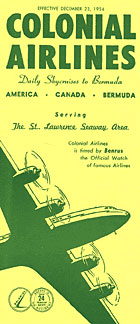
In the 1940 census of Norristown, Montgomery county, Pennsylvania as Theodore Heysham Jr., a 36 year old Asst. Sales Mgr for a Tile Manufacturer. I suspect this was the American Olean Tile Company, of Lansdale, which was owned by Theodore's brother-in-law, Roy A. Schweiker. Living with Theodore was his wife, Virginia F., a 31 year old Art Teacher at a Private School. He was living in the home of his widowed mother, but was listed as a renter.
Theodore Jr. continued to be listed in the Norristown directory with little change through 1947, though in 1944 his occupation was altered to "sls mgr (Landsdale)."
Theodore and Virginia vacationed in Bermuda in 1951.
"Colonial Airlines, aircraft N4269, from Kindley Field, Bermuda to LaGuardia Field, New York, arrived on 20 October 1951. Passengers: Theodore and Virginia F. Heysham, of 225 Jacoby St., Harristown, Pennsylvania . . ." - from "New York Passenger Lists, 1820-1957"In the 1951-1953 City Directory of Norristown as "Heysham Theo jr (Virginia F) asst sls mgr (Lansdale) h 350 Montgomery av Coleston." Virginia had her own line entry as "Heysham Virginia F Mrs art tchr Holland School r 350 Montgomer av Coleston." In 1955 the directory showed a change, to "Heysham Theo jr (Virginia F) pres Exchange Club of N'town h 350 Montgomery av Coleston." His mother, Ella, continued to live on Jacoby street.
Theodore died in January 1971 still living in the vicinity of Norristown, Pennsylvania. Virginia died 4 years later, in August 1975. I don't know of any children from this union. If there were none, then I believe this line of the family ended here.
(25) Sara Reese Heysham (1906)She was born on 12 June 1906 near Trooper, Montgomery county, Pennsylvania. She was named in honor of her mother's family. In the 1910 census of Norriton township, Montgomery county, Pennsylvania as Sara Reese Heysham, 3, living with her mother, Ella R. Heysham, 36, in the house of her grandfather, William J. Reese, 75. In the 1920 census for Norristown as Sara Reese Heysham, 13.
In 1924, at the age of 17, she won first prize in the American Legion's second annual national essay contest. The essay subject was "Why America Should Prohit Immigration for Five Years." Miss Heysham's essay, which I've scanned, is decidedly not 'PC.' The general drift being that the current immigrants are coming from the wrong countries, i.e. Southern Europe, so they should be stopped. First prize amounted to $750 to be used to defray college expenses. She graduated with an A.B. from Bucknell University in 1928.
In the 1930 census of Norristown as Sarah Heysham, a 23 year old Public School Teacher. She took a transatlantic voyage to Europe, returning in August 1933.
"S.S. AMERICAN TRADER sailing from London, England August 18th 1933, arriving at port of New York August 28th 1933An Elizabeth Wilson, 26, also of Norristown, may have been her travel companion.
Heysham, Sara, 27, Female, Single, West Norritown [sic] Township, Pa. June 12, 1906, 225 Jacoby Street, Morristown [sic], Penna." - from "New York Passenger Lists, 1820-1957"
"Heysham Ella R (wid Theo) h225 Jacoby
Heysham Sara R tchr David Rittenhouse Jr High School Jacoby
Heysham Theo jr (Virginia) slsmgr r225 Jacoby" - from "Boyd's Norristown Directory" of 1936-1937
In the 1940 census of Norristown, Montgomery county, Pennsylvania as Sara R. Heysham, a 33 year old teacher. She was living with her mother, Ella R. Heysham, a 66 year old widow, and Rebecca W. Price, a 28 year old teacher and boarder, at 225 Jacoby street.
In the 1953 City Directory of Norristown as "Heysham Sara R tchr David Rittenhouse Jr High School."
She married Lewis Kost before 1955 when she was listed in the Norristown directory as "Kost Lewis V (Sara) prin Eisenhower Sr High sch r 225 Jacoby." She died mid-20th century.
(24) Dr. Horace Besson Heysham (1873)I've also seen him referred to as Horace Bennson Heysham, but the sister of his grandmother, Anne Stewart, married a J. M. Besson which perhaps explains the name. An MD. He was born on 22 November 1873. In the 1880 Federal census of the 4th Ward, Norristown, Montgomery County, Pennsylvania as Horace Heysham, 7.
In a Directory of Norristown, for the years 1892-1893, when he was 19-20 years old, he was living at 330 DeKalb street, his occupation was listed as Clerk. A second listed address was 225 East Jacoby, his father's address.
Horace Besson Heysham received a Ph.G. [Graduate in Pharmacy] from the Philadelphia College of Pharmacy. His thesus was on Aconitum U.S.P. - from "The First century of the Philadelphia College of Pharmacy, 1821-1921" by Philadelphia College of Pharmacy and Science.
"--Horace B. Heysham, '95, who is the manager of the pharmacy in Bridgeport, owned by Charles B. Ashton, intends resigning next month so as to study medicine at Jefferson College, Philadelphia." - from "Alumni Report" Volume 33 of the Philadelphia College of Pharmacy of 1896.
Apparently Horace followed through on his plans. In the 1900 census of Norristown as Horace B. Heysham, a 26 year old [November 1873] physician. He was living with his mother, Sallie E. Heysham, a 60 year old widow, and his brother, Theodore, a 36 year old minister of the gospel. A member of the Montgomery County Medical Society.
"Dr. Horace B. Heysham has opened an office in Norristown." - from "The Journal of the American Medical Association" of 1901.
On 21 March 1902 a Dr. Heysham delivered the son of William Kevin Lanan Sr. and his wife Mary Emma Undercuffler in Norristown, Pennsylvania. The child was named Horace Heysham Lanan. According to his son, Horace Heysham Lanan Jr., the name "Heysham" came from the last name of the doctor who was present at Horace's birth.
1906. "Dr. Horace B. Heysham, Norristown, is convalescing from a long sickness." - from "The Pennsylvania Medical Journal"
He died on 13 November 1915 in Norristown - from "The First Century of the Philadelphia College of Pharmacy." He was buried in Montgomery cemetary.
(23) Dr. Charles Stewart Heysham (1825)He was born on 17 November 1825 in Philadelphia. His middle name was undoubtedly given in honor of his mother's family. Not in Theodore Heysham's family listing, but in the Larry Cassel geneology as a son of Robert and Ann Stewart. Note the use of Stewart in his middle name, substantiating the link. He grew up in Philadelphia and studied medicine at the University of Pennsylvania. Of Newton Square, which is a suburb of Philadelphia, 15 miles to the west. From a list of "University of Pennsylvania Medical Department Matriculants, 1806-1852,"
Charles Stewart Heysham, Barren Hill, Montgomery county, Pennsylvania, 1848 (462), [d. 27 July 1887, Newtown Square, PA] 1849 (14) $
- Note, $=received M.D.
| Barren Hill
A small hamlet at a cross-roads about 12 miles northwest of Philadelphia. The site of a Revolutionary war battle, the first in which a young Marquis de Lafayette commanded. It is today the suburb of Lafayette Hill. |
In the 1850 census of Newtown Township, Delaware County as Charles S. Heysham, a 25 year old physician. He was living with Thomas and Elizabeth Calvert. Thomas Calvert was listed as a Victualer. This may have been a rooming house he used while he was building his practice. Sometime soon after this he married Margaret Brooke. They had one child, Elizabeth.
Charles eventually had a large practice in Newton Square, Delaware county, Pennsylvania.
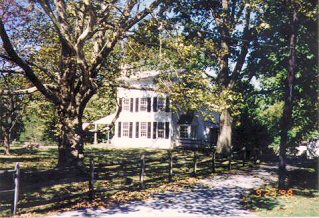
The Heysham House at 3523 East Goshen road, Newtown township, Delaware County, Pennsylvania, left, is a designated historical site in the national register. This early Federal house is named for Dr. Charles S. Heysham, a 19th century physician who purchased the house in 1835 [sic] from Martha Garret. Nothing is known of the earlier owners. Built of stone, with stucco, it is 2 1/2 stories with a fieldstone foundation and a low pitched gable roof. There is also original glass, and a beautiful wainscotted fireplace with pilaster on the first floor. |
Dr. Charles S. Heysham was a Vestryman of St. Davids Church, Radnor from 1850-1865 - from the "History of Old St. David's Church, Radnor, in Delaware County, Pennsylvania." Charles Heysham was also listed under the title "Roll of Lay Deputies," though he was not at the convention, representing St. David's church. - from the "Journal of the Proceedings of the Sixty-Sixth Convention of the Protestant Episcopal Church in the Diocese of Pennsylvania" held in St. Andrew's church, Philadelphia on 21 to 24 May 1850.
"A Pleasant Trip. -- Dr. C. H. [sic] Heysham, of Newtown Square, has just returned from a trip down the bay. He started on Monday on the yacht Sallie and Annie, Captain Blizzard, and went as far as Port Penn, where the time was spent in crabbing and fishing. He reports having a good time." - from the 5 September 1878 Chester Daily Times.
In politics he was a Democrat, serving on a committee to resolve the issue of contested seats at the Democratic county convention. Dr. Heysham represented Newtown. - from the 5 September 1879 Chester Daily Times.
From the "History of Delaware County, Pennsylvania" by Henry Graham Ashmead, Philadelphia, L. H. Everts & Co., 1884, Charles C. [sic] Heysham was:
- A director of the public schools for Newtown township, Delaware county, Pennsylvania in 1850, 1854 and 1857.
In the 1860 census of Newtown, Delaware county, Pennsylvania as Chas. S. Heysham, a 35 year old physician. Living with him were his wife, Margaret, 28, his daughter, Elizabeth, 6, and his father, Robert, 60. He had real property valued at $5000 and personal property valued at $1000. At the same address were two farm laborers, Johan Shane and Ge. Doumm, and a domestic, Sallie E. Hoopes, 21 (see the marriage of Robert, Charles' elder brother, above).
Soon after this Margaret died. She was only 29 years old. She was buried at the Radnor church on 6 December 1860. Charles then married Fanny Phipps Rushton. They resided in West Chester, still near Philadelphia. Fannie was born in October 1840. Her father was John Y. Rushton, a merchant from Philadelphia. He apparently was from England and was naturalized in 1865. Fanny and Charles had one child together, Grace
Doctor Heysham was the executor of Mary Taylor's estate. From the Delaware County American of 7 April 1869.
"EXECUTOR'S NOTICE. - ESTATE OF MARY TAYLOR, LATE OF EDGMONT TOWNSHIP, DEL., CO., DEC'D. - Notice is hereby given that letters testamentary upon the estate of Mary Taylor, late of Edgmont township, Del. co., dec, have been granted to the subscriber. All persons indebted to said estate will make payment, and those having claims present them for settlement to DR. CHAS. S. HEYSHAM , Executor.
In the 1870 census of Newton, Marple post office as Charles Heysham, a 41 year old [shouldn't he be 45?] physician. Living with him were his wife, Anna [Fanny's real name?], 29, and children, Elizabeth, 16, referred to as "without occupation," and Grace, 6. They had a single domestic servant, Mary Smith, aged 19. Ellen Rushton, 60, undoubtedly Fanny's mother, and Grace Rushton, 21, her sister [?], were also living with them. There was also a John White, 3 years old. Who was he? Perhaps he was Grace's son.
Charles was an appointed officer of the Masons - from "Early recollections of Ardmore" by Josiah Sibley Pearce.
From the "History of Delaware County, Pennsylvania" by Henry Graham Ashmead, Philadelphia, L. H. Everts & Co., 1884, Charles S. Heysham was:
- A charter member of the Okehocking Tribe, No. 159, of the Improved Order of Red Men. The Okehocking tribe was formed in November 1871. The meetings of the tribe were first held in the basement of Newtown Hall, and later a wigwam was furnished in the second story of the hall which is now used for that purpose. The tribe had thirty-eight members.
| Improved Order of Red Men
This is a fraternal organization, similar to the Elks, Lions Club, Rotary, etc, and is, in fact, the oldest of its kind. It was founded in 1765 and was originally known as the Sons of Liberty and Sons of Tammany of Philadlephia. These patriots concealed their identities and worked "underground" to help establish freedom and liberty in the Early Colonies. They patterned themselves after the great Iroquois Indian nation and its democratic governing body. 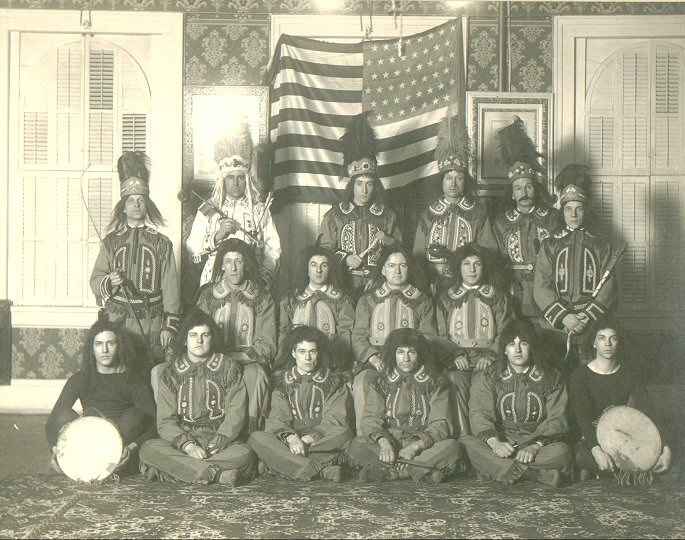 After the American Revolution the name was changed to The Order of Red Men. They kept the customs and terminology of the Indians as a basic part of the Fraternity. Some of the words and terms may sound strange, but they soon become a familiar part of the language for every member. The Masons are similar to the Order of Red Men in that they have patterned their rituals and work after the Ancient Masonic Craftsman. The Order of Red Men remains a National Fraternal Organization, though it appears to be rather right-wing. A local group of Red Men is called a Tribe, and its Lodge is called a Wigwam. The supreme head of the order is called the Great Inchonee. The officers of a Tribe are: Sachem (chief); Prophet (chaplain); Senior Sagamore (lesser chief); Junior Sagamore (lesser chief); Chief of Records (secretary); Collector of Wampum (financial secretary); Keeper of Wampum (treasurer). |
From the "History of Delaware County, Pennsylvania" by Henry Graham Ashmead, Philadelphia, L. H. Everts & Co., 1884, Charles S. Heysham was:
- Justice of the Peace, Newtown township, Pennsylvania, on March 24, 1874 and March 27, 1879.
- In 1883, a member of the Delaware County Medical Society.
In the 1880 Federal census of Newtown township as Charles S. Heysham, a 54 year old physician. His parents were listed as both born in Pennsylvania. Living with him were his wife, Fannie B. [sic], 39, and his daughter, Grace, 16.
He died on 27 July 1887 in Newtown Square, Pennsylvania at the age of 62 and was buried at the Radnor church, Radnor, Pennsylvania, a suburb of Philadelphia. - from an alphabetical list of internments in Radnor Church burial ground, 1716-1906, "The History of Old St. David's Church, Radnor, in Delaware County, Pennsylvania" prepared at the request of the Historical Society of Delaware County Pennsylvania, 1907.
In "Boyd's Chester County, Pennsyvania Directory, 1896-97" as "Heysham Fanny T., widow Charles S., h 606 S. Walnut."
In the 1900 census of West Chester, Chester county, Pennsylvania as Fanny P. Heysham, a 59 year old [October 1840] widow. She was living with her daughter, Grace, 36 [September 1863], and her husband, Walter H. Yerkes, 43 [January 1857].
In 1910 Fannie P. Heysham [Hiysham in Ancestry.com], 69, was living with her son-in-law, Walter Yerkes, and his family, in E Ward, West Chester Borough, Chester, Pennsylvania.
"Heysham, Fannie P. Wife of Dr. Charles S. Heysham, born 10-27-1840, died 8-7-1916" and was buried in the Newtown Friends Graveyard.
Charles' and Fannie's chidren were,
(24) Elizabeth G. Heysham (1854)
(24) Charles T. Heysham (1856), perhaps
(24) Grace Heysham (1863)
(24) John Y. Rushton Heysham (c1865)
The daughter of Charles and Margaret Heysham in the 1860 Delaware county census. Listed in the 1870 census. She married a Jones.
(24) Charles T. Heysham (1856)He was born on 17 June 1856, the son of Dr. Charles Heysham and his wife, Margaret. He died and was buried in the Radnor church burial ground on 1 November 1856, aged 4 months and 13 days.
Note that there is a list of short biographies of notable Pennsylvania men, "Chester (and its Vicinity), Delaware County in Penna. with Genealogical Sketches of some old families," 1877, which includes Dr. Charles S. Heysham and a Dr. Charles T. Heysham, who I assume are father and son. I have not been able to read the actual biographies. Who was this latter-day Charles T?
(24) Grace Heysham (1863)She was born on 16 September 1863 in Newtown Square, Delaware county, Pennsylvania. In the 1870 census as Grace Heysham, 6. She was living with her parents, Charles, 41, and Anna, 29, and sister, Elizabeth, 16. Also living in the house was a servant, Mary Smith, and relatives, Ellen and Grace Rushton. In the 1880 Federal census she was living at home with her father, Charles S. Heysham, aged 16.
Grace married Walter Howard Yerkes on 22 March 1888. He was born on 10 January 1857 in New Garden, Chester county, Pennsylvania, the son of Job Roberts Yerkes and Elizabeth Pierce.
"Yerkes - Heysham.--At the residence of J. Penrose Dunwoody, Newtown township, Third month 22d, 1888, by Friend's ceremony [Quaker?], Walter H. Yerkes, of East Bradford, Chester county, Pa., son of Job R. and Elizabeth P. Yerkes, and Grace, daughter of Fanny P. and the late Charles S. Heysham, of Newtown." - from "Friend's Intelligencer" Volume 45Another version of the same event:
"Grace, daughter of Fanny P. Heysham, married Walter Yerkes (Yorkes). Walter, the son of Job Roberts Yerkes and Elizabeth Pierce, was born in New Garden, Chester county, Pennsylvania on 10 January 1857. He and Grace married on 22 March 1888."They had three children, Frances, Earle and Lydia.
In the 1900 census of West Chester, Chester county, Pennsylvania as Grace H. Yerkes, 36 [September 1863]. Living with her were her husband, Walter H. Yerkes, 43 [January 1857], children, Fannie, Earle, and Lydia, and her mother, Fanny P. Heysham, a 59 year old [October 1840] widow.
In the Pennsylvania 1910 Miracode Index, Grace was 46 years old and her mother, Fannie, 69, was living with her and her husband Walter Yerkes.
(24) John Y. Rushton Heysham (c1865)A son. Undoubtedly named for his maternal grandfather, John Y. Rushton. He died as an infant and was buried at the Radnor church - from an alphabetical list of internments in Radnor Church burial ground, 1716-1906, "The History of Old St. David's Church, Radnor, in Delaware County, Pennsylvania" prepared at the request of the Historical Society of Delaware County Pennsylvania, 1907.
(23) Elizabeth Greenleafe Heysham (1829)
She was born on 18 August 1829. Elizabeth Heysham, the daughter of Robert, died on 22 or 233 October 1845 in Radnor, Pennsylvania at the age of 16 or 17 - from the Philadelphia Death Certificate Index.
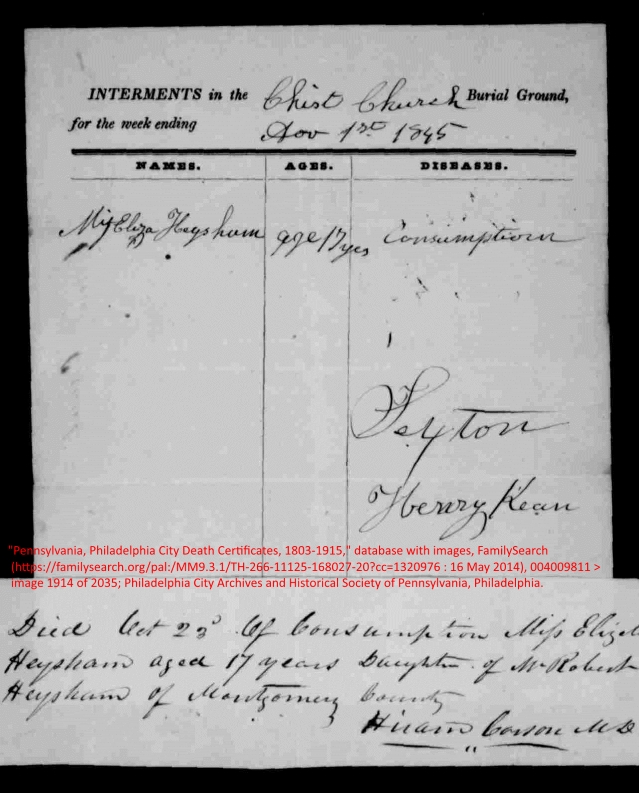
"Died,I wonder where Greenleafe comes from? She had a niece, Elizabeth G., who may have been named for her. (23) Theodore Farrouilh Heysham (1834)At the residence of her father, near Plymouth, Montgomery county, on Wednesday morning, 22nd instant, Elizabeth Greenleafe Heysham, daughter of Robert Heysham, in the 16th year of her age.
The friends of the family are respectfully invited to meet the funeral at Christ Church burial ground on Friday next, at 2 o'clock, P.M."
I learned of Theodore's odd middle name from J. McBride, who saw if on Theodore's death notice in the Philadelphia Inquirer. There was an Andrew Farrouilh in the 1814 Philadelphia directory who may have been the source of this name.
Theodore was born on 21 September 1834. In the 1850 census of Plymouth township, Montgomery county, Pennsylvania as Theodore Heysham, 14. He was living with Robert Heysham, 26, and his sister, Margaret, 12.
He died on 10 September 1852 in Radnor township, Pennsylvania at the age of 18. The Death Notice of Theodore F. Heysham was carried in The Delaware County Republican of 24 September 1852.
Death Notice At the residence of his brother, Dr. Charles S. Heysham, Newtown Square, Delaware county, THEODORE F., youngest son of Robert and Ann S. Heysham, aged 17 years, 11 months and 20 days. A victim of pulmonary consumption, he met his end cheerfully and without fear, being buoyed up in his last moments by a lively hope of a blissful immortality."He was buried at the Radnor church. I suspect that (24) Theodore Heysham, his nephew, was named in rememberance of him. (23) Margaret Heysham (1838)
She was born in about 1838. In the 1850 census of Plymouth township, Montgomery county, Pennsylvania as Margaret Heysham, 12. She was living with her brothers, Robert, 26, and Theodore, 14.
(22) Alexander Hamilton Heysham (c1804)Cited in Theodore Heysham's genealogy, per Roberts' Bios: Vol II - Part 2. The second son of Captain Robert Heysham. Also noted in Theodore Banta's "The Sayre Family." His naming says something about his father's politics. Note Robert Heysham was in the "notorious" Provisional Army, which was under the command of Alexander Hamilton, see above.
According to "Crozier's General Armory" by William Armstron Crozier, the Robert Heysham family may still have been living in Washington, D.C. as late as 1803. If so, then Alexander may have been born in that city. His younger brother, John, was said to have been born in Bucks county, Pennsylvania in about 1803.
Alexander apparently followed in his grandfather's footsteps and became a seaman. Seamen's Protection Certificates were authorized by Congress in 1796 to identify American merchant seamen as citizens of the United States to protect them against impressment. The following entry is read in the following columns, Last name, First name, Date of application, Age, State of birth.
"Heysham, Hamilton 1818 14 PA" - from the "Index to Seamen' Protection Certificate Applications, Port of Philadelphia 1769-1823."During this period 14 was a typical age to go to sea. Ancestry.com says this document was dated 26 November 1818.
In the 1820 census he was either at sea or being counted in his father's household.
A. H. Heysham arrived in Philadelphia on 21 September 1825 onboard the SARAH RALSTON, from Hamburg. However, it shows him as aged 14, when he should have been 21 - from "Philadelphia, 1800-1850 Passenger and Immigration Lists."
"[Name] Heysham, A.H., [Accompanied by] blank, [Age] 14 yrs, [Sex] N.G. [not given?], [Occupation] Child, [Nationality] U.S., [Last permanent residence] blank, [Destination] U.S., [Port of entry] blank, [Name of vessel] Ship SARAH RALSTON, [Date] 9-21-1825"Could this be the wrong person? There aren't many other A.H. candidates available.
| SARAH RALSTON
In 1824 a Philadelphia firm of Liverpool packets owned by John Welsh included the MANCHESTER, SARAH RALSTON, PLATO and PHILADELPHIA. They sailed from Philadelphia on the 5th of each month, and from Liverpool on the 25th. They were attempting to compete with the Line owned by Thomas P. Cope and folded after only a few years and the SARAH RALSTON went back into regular service. Note that it was Cope that gave an apprenticeship to William Heysham Sayre, the grandson of Captain William Heysham. The SARAH RALSTON was a full-rigged ship, that is it had three masts, built in about 1824 and carried many immigrants to American in the 1820's. In 1824 the SARAH RALSTON had been under the command of Ezra Bowen, but he and one of the boys were swept overboard in a storm. In a crew list of June 1825 the Captain was Charles Winslow. I don't see Alexander on this list. Note that of a crew of ten (plus the Captain), seven were said to be of a Black complexion, one yellow, and two merely dark. All had "woolly" hair. I assume this means they were African in origin, and so does the author of the source, Martha S. Putney's "Black Sailors: Afro-American Merchant Seamen." The Captain's hair and complexion were not noted. From an advertisement in 1827, "For London. The ship 'Sarah Ralston' captain WINSLOW, to sail about the 1st September, a fast sailing, coppered vessel and three years old." - from The National Gazette & Literary Register of Philadelphia, 23 August 1827.By the way, Sarah Ralston was a reforming Quaker woman who founded a home for indigent women in Philadelphia in 1817. |
Alexander was living on 4th street in 1829.
"Heysham Hamilton, mariner S 4th bel Catherine"Bel" means below, so the address is 4th street, below Catherine street. That is, perhaps, between Catherine and Kauffman streets.
Heysham Robert, naval clerk at the custom house 203 N 9th" - from the Philadelphia Directory of 1829
In the 1830 census of Cedar Ward, Philadelphia as Alexr H. Heysham [Alexr M. Hysham in Ancestry.com]. Cedar ward is in the southwest, and newer, part of the city. In the household were 2 boys aged 10-15, a man aged 20-30 years old [Alexander], a girl aged 10-15, a woman 20-30 years old, and a woman aged 40-50, probably a mother-in-law.
| Cedar Ward
Extends within a line from Fourth Street, thence by Spruce Street to the Western boundary of the City, thence by the same to the southern boundary thereof [South Street], thence by the same back to Fourth Street, and thence by the same to the place of beginning. 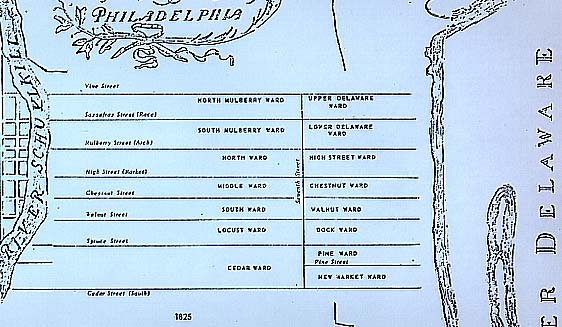 |
According to Theodore Banta, Alexander died on 24 July 1830 at the age of 26, in Philadelphia, unmarried [sic]. This is confirmed in the following snippet,
"Heysham, Mr. Alexander Hamilton. Son of the late Capt. Heysham. Died at Philadelphia on Sat. morning July 24th in the 26th year of his age. National Banner & Nashville Whig." - from "Obituaries from Early Tennesse Newspapers, 1794-1851" by S. Emmett LucasWhat happened to his children, or were the members of his household in the 1830 census not family? Like his brother, William Sayre Heysham, Alexander was an author, published posthumously. From the tone of the story Alexander was an officer of the ship.
"The Messenger; or, A Yarn Upon the Lee Booms, A Sea Story.(22) Mary Heysham (c1800)
By the Late Alexander Hamilton Heysham.The captain and myself had been talking over the probable length of our voyage, when the bell struck eight, and the men below were turned up for the first night watch. Not being in a humour for sleep, I went on deck. The night was beautiful. Those who have never witnessed a moon-light night at sea, can form no idea of its splendour. We had the wind free and a moderate breeze; the ship was going through the water at the rate of about seven knots; every sail that would draw was crowded upon her, and never in the course of many voyages had I witnessed a scene more grand or beautiful . . . " - from "Godey's Magazine," 1830
According to Theodore Banta, Mary died on 8 June 1840 in Philadelphia, unmarried. However, I show that Mary Heysham, a single woman aged 40, died on 8 July 1840 in Philadelphia and was buried in the Christ Church burial ground - from the Philadelphia Death Certificate Index. Below is her death certificate.
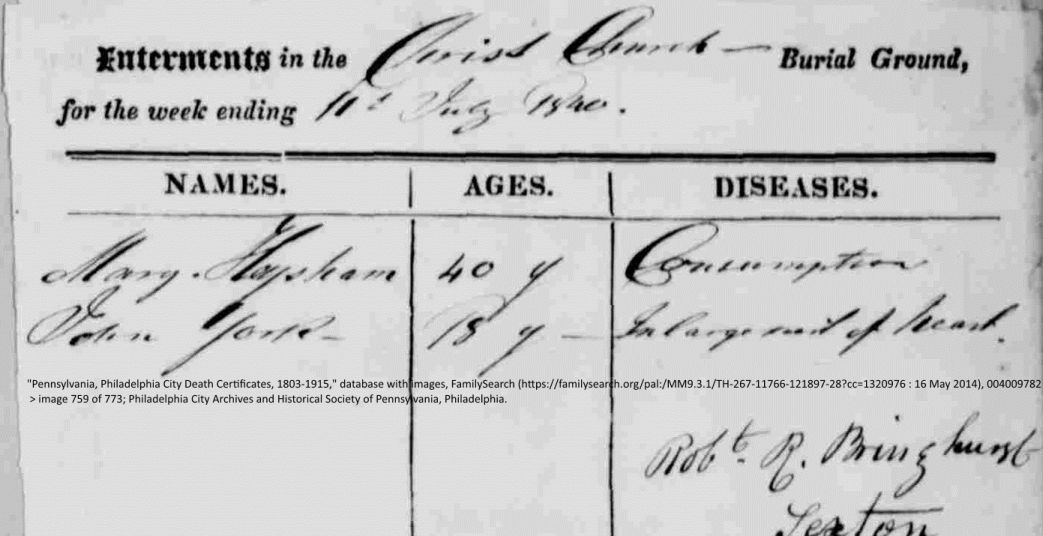
Mary Heysham was buried on 9 July 1840.
"July 9th 1840 Estate of Mary Heysham to Mahogany coffin (Paid)Two of Philadelphia's oldest undertakers were Andrew J. Bair and Son, and R.R. Bringhurst and Company, at 1924 Arch Street. Both firms were founded in 1822 and merged in 1972. Bringhurst was Philadelphia's "carriage trade" undertaker, handing the funerals of city notables. (22) John Gibbon Heysham (1803)
1/2 bushel of Tee . . . 12 1/2
Hearse from Yates carriage from Stand" - from "R.R. Bringhurst and Co. Records" in "Pennsylvania and New Jersey, Church and Town Records, 1708-1985"
John Heysham, the son of Robert and Mary Heysham was probably born in Philadelphia. John was baptized on 20 November 1810, along with elder sister Mary, at the Union Methodist Episcopal church. Mary was listed as an "adult," she was about 20, but John's birth was shown only as "---."
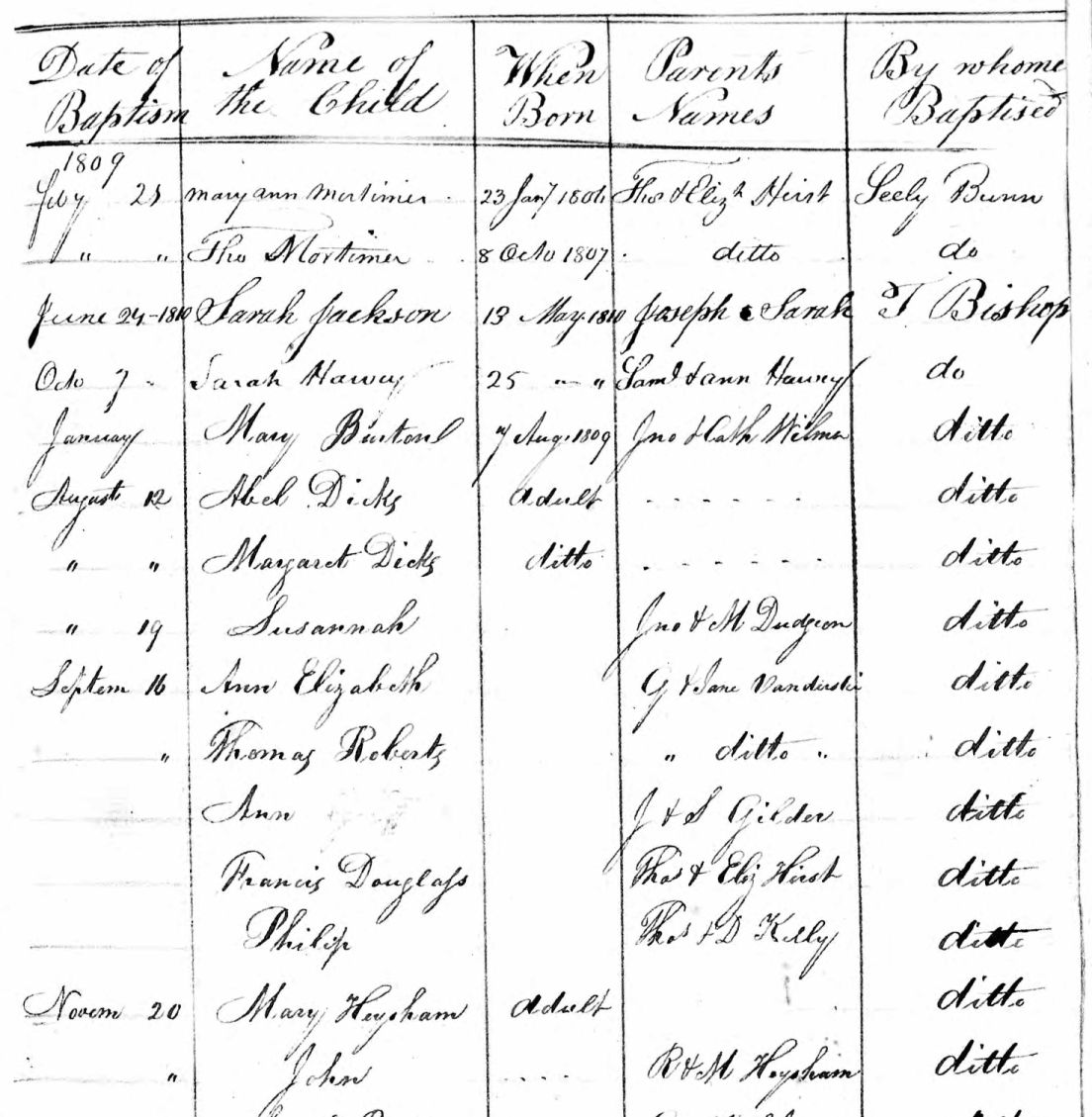
Robert had married Mary circa 1797. I don't show that Robert ever lived in Bucks county, but, the region does border northeastern Philadelphia. The suburb of Holmesburg, where the family of John Heysham Gibbon settled, was in northeastern Philadelphia county, just south of the Bucks county line.
| Bucks County
One of William Penn's three original "super" counties, it is today a small county of 590 square miles, bordering the Delaware river, between Phiadelphia county and the modern Northampton county. Note, the Thomas Heysham family of Lower Smithfield lived in the original Northampton county, but what is now Pike county, which is much further to the north. |
According to "Crozier's General Armory" by William Armstron Crozier, the Robert Heysham family may still have been living in Washington, D.C. in 1803. If so, then John was born very soon after the family returned.
Theodore Banta, in "The Sayre Family," has this son as John Gibbon Heysham, though most sources call him just John Heysham. Robert's brother-in-law was Dr. John Hannum Gibbon and presumbaby John had been named in his honor. Another son, William Sayre Heysham, was given a middle name in honor of Robert's other brother-in-law, Dr. Francis Bowes Sayre.
There is a reference below, which I've attributed to Edward Heysham, a known lawyer, which mentions a "Mr. John Heysham, a lawyer of some prominence in the early fifties . . ." I claim this isn't our John Heysham because John had died by 1831.
Accordinng to Banta, John died in Matansas on 4 July 1831, unmarried. He would have been only 28 years old. This appears to have been Matamoros, Mexico and the date may have been 21 July. Matamoros, before 1826 known as Refugio, is in the northeast of Mexico, on the southern bank of the Rio Grande river, across from Brownsville, Texas. A port was built there in 1823 that supported trade with New York, Philadelphia, and New Orleans. By the mid-1830's Matamoros had become a commercial center dominated by transients and foreign merchants - from "River of Hope: Forging Identity and Nation in the Rio Grande Borderlands" by Omar S. Valerio-Jimenez. There may have been a commercial or maritime connection for the family.
Another reference says,
"Americans at Matamoros, Mexico, 1828-1851
Dimitt, Philip, reported 26 Sept. 1841; native of Kentucky.
Downs, Charles, reported 10 Nov. 1851.
Downs, George, reported 10 Nov. 1851.
Farrouilh, Andrew, died 16 Nov. 1833; naturalized citizen, native of France, resided many years in Philadelphia; mother resides in Palai, a small village in the interior of France; friend in Philadelhia, Geo. Guier.
Fosdick, Dr. Wm., reported 10 Aug. 1849.
Frazier, Wm. T., reported 10 Aug. 1849.
Frink, W. C, reported 10 Nov. 1851.
Garrison, Abraham, reported 23 Mar. 1835; relatives live at Geneva, Ontario Co., N.Y.; father is a Revolutionary War pensioner, both parents alive and supported by their children; inquiry from Bowen Whiting, friend of the family.
Gleason, C K., reported 10 Aug. 1849.
Green, Thos. S., reported 10 Aug. 1833; mother, Mrs. Cassandra Green(e) of Baltimore; inquiries from S. Pleasanton and I. P. Heath of Baltimore; Samuel Harris of Baltimore, son-in-law of Mrs. Green.
Grant, William, reported 11 Nov 1831; came in the brig Jane, Williams, master, from New York; father resides in Albany, N.Y.
Hysham, John G., died 21 July 1831; of Philadelphia; mother there in indigent circumstances.
Irlet, Charles, died 20 Aug. 1833; of New Orleans, lived at Mobile several years; native of Switzerland, became a citizen 12 Jan. 1825, granted by Marine Court, City of New York; died of cholera morbus on road to Mier where he owned a small store.
Kirk, Thomas, died 9 Jan. 1848; Sarah Kirk to receive effects and land warrants; inquiries by Hon. J. W. Jackson and J. F." - from "Americans at Matamoros, Mexico, 1828-1851" by Elizabeth Pearson White, C.G., in the "National Genealogical Society Quarterly", pg 29
John's father, Robert, had died in 1822 and I don't see his mother, Mary, in the 1830 census.
(22) Ann Dorothy Heysham (1811)Ann Dorothy Heysham, the daughter of Robert and Mary Heysham, was born in about 1811 and died of an inflammation on 12 December 1812, at the age of 16 months, in Philadelphia and was buried at Christ Church.
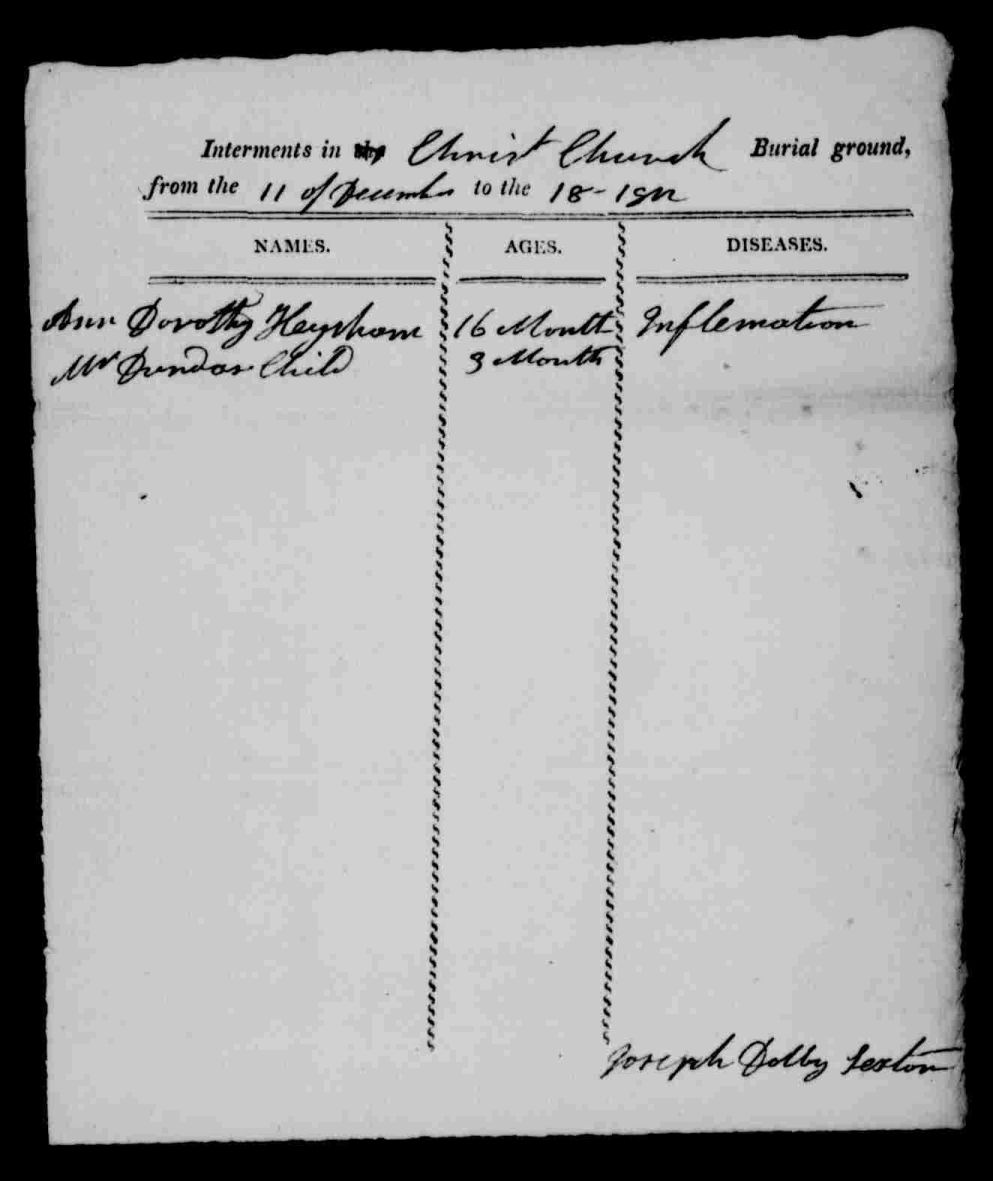
Ann Sayre Heysham, the daughter of Robert and Mary Heysham, was born on 1 July 1814 and died of cholera on 8 August 1814, at the age of 5 weeks, in Philadelphia, and was buried at Christ Church.
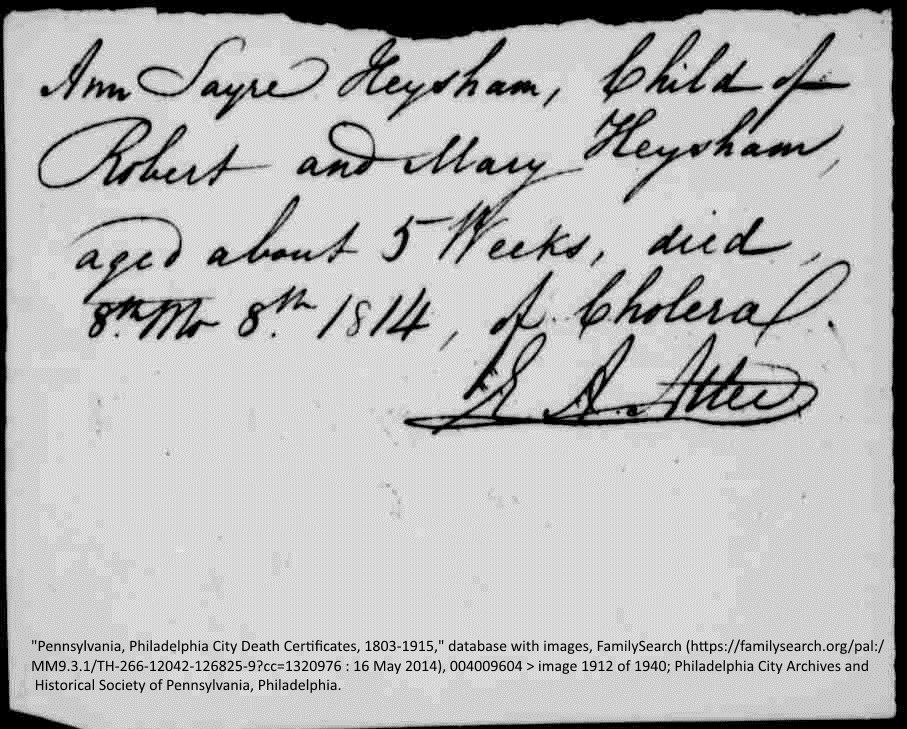
The fourth son of Captain Robert Heysham. According to Theodore Banta he was William Sayre Heysham. Why would Robert name his son for his sister's husband, Dr. Francis Bowes Sayre? Were they that close or was the Sayre connection that prestigious? Remember that Francis died while ministering to the sick during the Yellow Fever epidemic in Philadelphia, being in the process something of a hero. Perhaps this naming was an encomium to him.
In the 1820 census of the Northern Liberties Ward 3, Philadelphia, Pennsylvania William would have been living with his father, Robert Heisham [Hersham in Ancestry.com]. In the household were 2 boys who were 0 to 10 years old, William & Edward, 1 who was 10 to 16, John, 1 16 to 18, ?, 2 who were 16 to 26, Robert Jr. & Alexander Hamilton, and one man over 45, Robert. Of women, 1 was 0 to 10, Frances, 1 was 10 to 16, Mary, one was 16 to 26, Margarita, and another was 26 to 45, Mary. Two members of the family were engaged in commerce; this was probably Roberts Sr. and Jr. There was also a free colored woman, aged 14 to 26, in the house.
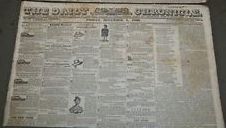 William became a newspaperman and printer, starting his career at the "Daily Chronicle."
William became a newspaperman and printer, starting his career at the "Daily Chronicle."
"Forty-seven years ago we remember Louis A. Godey as chief clerk in the Daily Chronicle office, on Third, near Chestnut Street, where William S. Heysham and ourself were mailing clerks, and what might be called general devils of the publication office." - from "Godey's Magazine" of 1871I don't think the reference above means us to subtract 47 years from 1871 to date the event mentioned; by the math it would be 1824. The Daily Chronicle, published by Charles Alexander, did not start publishing in Philadelphia until 1828 and ceased, in its original incarnation, in 1834. At the earlier date William would have been 12, young, but not too young to be employed in the mail room and to be a "general devil." Louis Antoine Godey left the Chronicle in 1830 to publish the first successful woman's magazine, "Godey's Lady's Book." In that year William would have been 14. Note that William's brother, Alexander, had a posthumous story, "The Messenger," published in Godey's Lady's Book in 1831. Below is a print of Chestnut street, near Third.
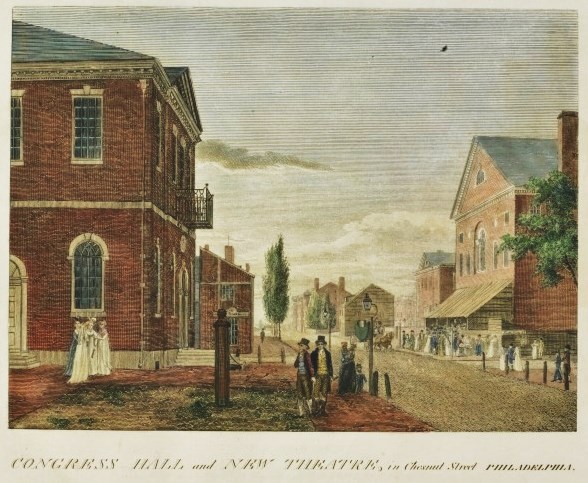
I don't see Robert Heysham and his family in the 1830 census.
William was, in the middle 1830's, a member of the Universalist Church, "devoted to the doctrine of universal benevolence, the defense of liberal policies generally in religion, and miscellaneous reading of chaste and moral tendency."
"The second anniversary of the First Universalist Institute, Philadelphia, will be celebrated in the Lombard-st Church, on Monday evening, March 21st. Brs. James L. Gihon, Wm. Fishbough, and William S. Heysham, have been appointed speakers for the occasion." - from the "Universalist Union" of 5 March 1836In 1834 Elijah Dallet Jr. had helped found and became the first President of the Young Men's Universalist Institute of Philadelphia. William Sayre Heysham was the Secretary of the Institute.
"ELIJAH DALLETT, Jr. President.In 1836 William was the Vice President.
Attest. Wm, Sayre Heysham, Sec'y."
- from "Nine Sermons on Important Doctrinal and Practical Subjects, Delivered in Philadelphia, November, 1834" by Hosea Ballou, Pastor of the Second Universalist Society in Boston
"At a semi-annual meeting of the First Universalist Institute, Philadelphia, holden in their hall, on Monday evening, April 11th, the following members were elected officers for the ensuing six months:Does it say something that this organization's Vice President was only 20 years old?
Abel Cha's Thomas, President,
William Sayre Heysham, Vice-President
. . ." -from "Universalist Union" of 1836
| The Universalist Church
The defining theology of Universalism is universal salvation; Universalists believe that the God of love would not create a person knowing that that person would be destined for eternal damnation. They concluded that all people must be destined for salvation. In revolutionary Philadelphia, Dr. Benjamin Rush was a leading Universalist, though not a member of the church. - from Wikipedia. Rush was a friend of Captain William Heysham. First Universalist InstituteThis was an association of young men, organized in the spring of 1834. |
| William Heysham Dallett
I'm interested in William Dallet because of his unique middle name, of course. Just how did he get that name and how does it bear on the William Heysham family of Philadelphia? William H. Dallett was born in Philadelphia in 1833. His father, Elijah had been born in Putney, Surrey, England in 1802, but his father, also named Elijah, emigrated to America soon after, settling in Philadelphia in about 1809. The elder Dallett, and his son after him, became involved in banking, import merchandize and shipping. Moving in those social circles Elijah Jr. would have met, and befriended Robert Heysham and, within his own generation, Robert's sons. Specifically, I think that it was William S. Heysham Elijah befriended, and for whom he named his third son, William Heysham Dallett. The Dallett's belonged to the Universalist church, and in 1834 Elijah Dallet Jr. had helped found, and became the first President of the Young Men's Universalist Institute of Philadelphia. William Sayre Heysham was the Secretary of the Institute. In my experience, the two officers who work most closely together in an organization, are the President and the Secretary. |
The following may be the address of William's newspaper office, "Heysham, Wm. Sayre, N W 5th & Commerce." - from "Philadelphia Directory" by A. McElroy of 1839. In 1840 the entry for William was the same.
"Heysham, Robert, clerk, Customhouse.In the directory of 1844 as "Heysham Wm. Sayre, 72 S 3rd ton wood ab 12th." The latter part of this is probably garbled. This was between Market and Chestnut streets.
Heysham, Wm. Sayre, N W 5th & Commerce."
In the 1840 census of Philadelphia, Pennsylvania as W. Sayre Heysham. He is located on two lines, but this doesn't appear to be a normal census. William is listed under the title of "Names of Counties & Assistants" for Philadelphia City. The numbers under, for example, males under 5, is 549. I think this means that William was the census taker for two neighborhoods in Philadelphia. However, I don't see William listed in the census himself.
| William Heysham of Ireland?
"Java 27 April 1846
Ancestry.com expands on this to show that William, a 25 year old young man, was one of 207 passengers, took passage in steerage and was a native of Ireland. There were a number of ships named JAVA, including an infamous ship on the England to Australia route. Our JAVA is probably the ship of Liverpool. Not all of the passengers were Irish emigrees. I have found one family of four that joined the ship at Bristol. They paid 12 pounds 10 shillings for the entire family. Other ports of embarkation included Liverpool. The Irish FamineThis horrible period, caused by a potato blight, lasted from 1846 to 1848. |
William was a Freemason from at least 1840 to 1848. In one citation he was called W. Sayre Heysham, the Worshipful Master of Lodge number 3. At one point he was also referred to as a P.M. [Past Master]. One example of the many repetitive citations:
"Phil., Monday, Septr. 6th 1847
Grand Lodge of Pennsylvania, Quarterly Grand Communication
Present:
. . .
[Bro.] Wm. S. Heysham"
. . .
Lodges Represented.
. . .
[No.] 3, Desilver, Heysham, Skerritt, King, English, McKaraher, Thomason, Florence . . ."
- from "Minutes of the Right Worshipful Grand Lodge of the Most Ancient Nad ..." by Grand Lodge, Freemasons Grand Lodge of Pennsylvania, Freemasons
William was the author of at least one political tract.
6 May 1843. Under the heading "Volunteer tracts," "By W. Sayre Heysham. James Buchanan--The model of an American statesman. Too pure for dissimulation; too lofty for impure ambition; too great to seek improper advancement; and looking only to general weal; too patriotic and too independant to endeavor to hide or varnish a single fundamental principal." - from "Niles Weekly Register"It is interesting that William so praised Buchanan who, in 1856, defeated the American party candidate for President, former President Millard Fillmore. William's brother, Edward, below, was a prominent member of the American party in Philadelphia. Was this sibling rivalry?
The following cites William's work as an amatuer playwright.
"William Sayre Heysham, author of a tragedy in five acts, founded on the history of Pelopidas and Epaminondas, called The Theban Pair, the title of which was suggested by Thomson's line:--The classical reader will at once appreciate the taste of Mr. Heysham, in his choice of a subject."And equal to them all, the Theban pair."
He has also written a domestic drama, in three acts, entitled Rich and Poor Kinsmen.
Also a patriotic play, the property of a popular comedian.
It is founded upon events in our own history, and will form an era in our national drama, which will at once do away with the opinion, so often expressed, that we have no stirring incident, or legendary lore in the land, of sufficient importance or interest to constitute the ground-work of a play.
We may remark, also, as regards this piece, that Mr. Heysham is of an old Philadelphia family, and the grandson of Captain William Heysham, who having left the British service, and adopted the cause of the colonies, was proscribed by the royal power [a little rewriting of history]. His father, Captain Robert Heysham, although very young, distinguished himself in the American army, during our revolution. In consequence of his connexions, and associations, Mr. Heysham has in his possession masses of documentary and epistolary papers; full of incidents of the glorious past, and we have no doubt that these papers have afforded him abundant material for the drama.
These dramatic productions of our friend, are the result of a literary employment, of occassional hours of leisure, snatched from the arduous duty of writing for a daily newspaper." - from "The Dramatic Authors of America" by James Rees
| 19th Century Theater in Philadelphia
While modern theater strives for naturalness, that of the 19th century aimed at the greatest dramatic effect through intense emotions and a stylized acting form [think hands clutched to heart to portray emotion]. Of the melodrama popular at the time, a critic writes, "Its conventions were false, its language stilted and commonplace, its characters stereotypes, and its morality and theology gross simplifications. Yet its appeal was great and understandable. It took the lives of common people seriously and paid much respect to their superior purity and wisdom . . . And its moral parable struggled to reconcile social fears and life's awesomeness with the period's confidence in absolute moral standards, man's upward progress, and a benevolent providence that insured the triumph of the pure."See the film "Age of Innocense" for a recreation of a popular play of the period. For us it is laughable in its contrivance, but the playgoers of the era were greatly affected. The Walnut street theater in Philadelphia, below in an etching circa 1831, is the oldest in America. The Walnut's first theatrical production, The Rivals, had President Thomas Jefferson and the Marquis de Lafayette in attendance on opening night. In 1820, Edwin Forrest, a young Philadelphian who would have a profound impact on American drama, made his professional debut on the Walnut stage at age 14. In 1828 John Haviland, the most prominent architect of his day, designed major renovations to the interior and exterior of the building. The present facade is based on his original design. Walnut Street Theatre is home to many firsts in the American theater scene. In 1837, the Walnut was the first theatre to install gas footlights, and in 1855, the Walnut became the first theatre to install air conditioning. 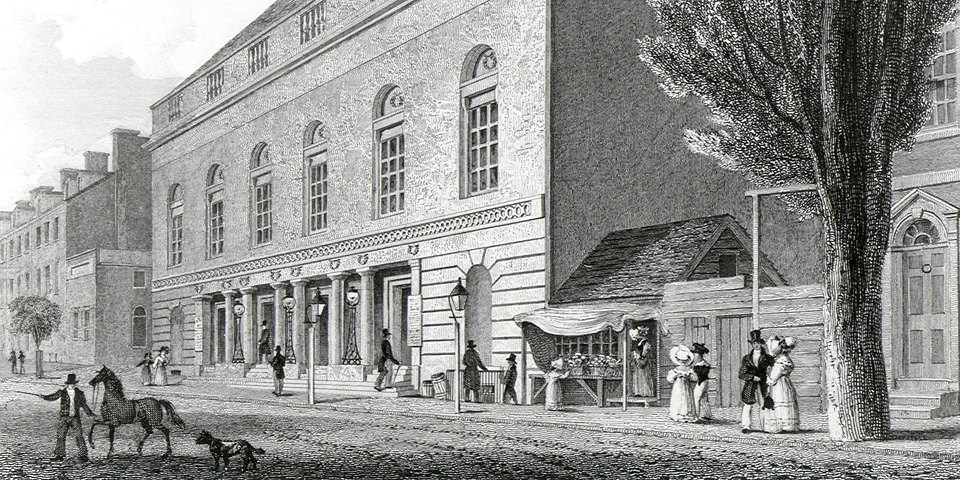 |
William died in Philadelphia on 7 May 1849, unmarried per Banta. However, according to the Philadelphia Death Certificate Index,
"Philadelphia Jany. 14th 1849The address of William's residence puts it just north of the City Tavern. In the etching below it is the building just shown on the right. There is a rather elegantly clothed gentleman pushing a wheelbarrow in front of it. This block is today occupied by the Philadelphia Passport Agency. The building in the middle was the Bank of Pennsylvania; today it is a parking lot.
Wm Sayre Heysham, residing at No. 152 South 2nd street, died this day of Pulmonary Consumption aged 33 years 6 months
Colour White . . . Occupation Printer . . . Single . . . Native of Philadelphia . . . Resided in Philadelphia 33 years
M. A. Gillingham M.D."
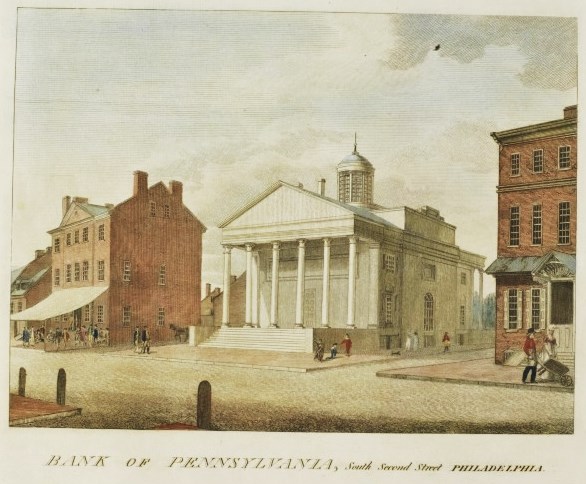
William S. Heysham was buried in the Christ Church burial ground. I don't believe there is a tombstone associated with his grave.
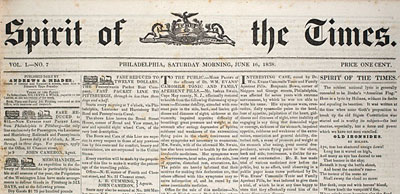
"Death of W.S. Heysham.--The Philadelphia Spirit of the Times announces the death of W. S. Heysham, who has been connected with the public press of Philadelphia for a number of years and for the past two years with that paper." - from "The Literary American" edited by George Payn QuackenbosThe "Spirit of the Times" and the "Daily Keystone" merged creating a new daily published by Manuel M. Cooke from 1847 to 1849.
According to Theodore Banta, a son of Robert, and married, but I know of no children.
"Mr. Edward Heysham submitted to an operation on the 7th of December last [1840], by Dr. Duffee, assisted by Dr. Condie and others, for an obliquity in the rignt eye inwards. The operation was of long duration, and consequently distressingly painfuL The eye was left most shockingly lacerated, and the most alarming inflammation followed. He was confined to his bed for upwards of a month, and, in his own language, "was so reduced that for half the time he was unable to move or eat." Language . . ." - from "The Baltimore Sun of 17 April 1841.
The following refers to the American Party, or No-Nothings, not to American Indians; see below.
"The Native American Association of Dcl [?] Ward on Monday evening, elected tha following named gentlemen a delegate to the nominating Convention to select a ticket for the city, via : Edward E. Jones, Edward Heysham, John W, Phillip, Urbaa Lynch and James G. Osborne." - from the "Public Ledger" of Philadelphia of 30 July 1845
Edward married Anna Booth Clay, the fourth child of Curtis and Elizabeth Lohra Clay, of Philadelphia. Walles' diary makes mention of this Mr. Clay as a scholarly man whom he met in Philadelphia. Mrs. Clay was a daughter of Peter Lohra, a distinguished American Patriot, who served as secretary for the commission that sat in Philadelphia in 1795. It settled the conflicting claims between the United States and Spain and resulted in the Treaty of San Lorenzo. At this time parallel 31 south was designated as the southern boundary of the infant United States. The Mississippi-Louisiana line is a part of this early edge of America.
The reference, above, unfortunately, has many pieces missing. Anna was born on 29 July 1807, in Philadelphia, and died in November 1886 in New Orleans, Louisiana and buried there - from "The Family of Clay of New Castle, Delaware and Philadelphia, Pennsylvania" by Cecil Clay. This was her second marriage. Her first husband was Richard Thomas Lewis with whom she bore four children. I don't see a date for her marriage to Edward, but it was before 1850.
Edward became a lawyer, having passed the Philadelphia bar on 6 February 1850 - from "Martins Bench and Bar of Philadelphia."
"Edward Heysham, Esq.--We are pleased to learn that Edward Heysham, Esq., passed a most creditable examination before the Board of Examiners, and was, on Thursday last, admitted to practice at the bar. Mr.H. is a talented gentleman, and we have no doubt will attain that position which his ability entitles him to." - from "The Law Journal" of 5 February 1850
I believe the following news item is for Edward, the only attorney of this family in Philadelphia.
"Intelligence By The Mails.I don't know the outcome of the trial.
Philadelphia, January 30, 1849.
. . .
The charge of extortion against Messrs. Blankman and Heysham, two young members of our bar, is now on trial in the Supreme Court. The offence charged is for obtaining more than $100 from Mrs. Gigon, for the purpose of settling a trifling suit for assault and battery, brought against her by another female. It will probably occupy the attention of the court for several days." - from "The New York Herald" of 31 January 1849
In the 1850 census of Philadelphia North Ward, Pennsylvania as Edward Heisham [Heishane in Ancestry.com], a 32 year old attorney at law, of Pennsylvania. Living with him was his wife, Anna, 40. They were living in a boarding house. Other people living there included a coach maker, a paper hangar, a tailor and a slave dealer. Anna seems too old to be having children in the future.
While the following indicates that it is talking about John Heysham, I think they meant Edward, the only lawyer in the family. The anecdote is, after all, about John Cadwalador, not Mr. Heysham, so the author wouldn't have been too concerned about first names.
"Mr. John Heysham, a lawyer of some prominence in the early fifties, and before Mr. Cadwalader was appointed to the bench of the Federal Court, told this, to some extent, possibly, fanciful story, as illustrative of Mr. Cadwalader's extensive legal scholarship and his fondness for minute consideration of every question. Leaving one of the old row-offices on Chestnut Street, one day, on his way to his midday luncheon, Mr. Heysham was confronted by Mr. Cadwalader. Mr. Heysham observed to his learned professional brother, that he, Heysham, had just been consulted by a client, the turnbuckles of whose house had been surreptitiously removed; and asked Mr. Cadwalader what he thought was the appropriate proceeding in vindication of the client's rights. Mr. Cadwalader, in his customary kindly manner, took Mr.Heysham's arm in his own, and proceeded to walk him out Chestnut Street, delivering on the way, a learned presentation of the law of turn-buckles, beginning awayback in the days of Cro. Eliz. And the black letter reports. Continuing to stroll around Broad Street to Spruce Street, and finally reaching Mr. Cadwalader's office in South Fourth Street, Mr. Cadwalader had reached a period but midway in the ambulatory essay. No conclusion had, however, been even approached; and the two pedestrians parted, with appreciative expressions on the part of Mr. Heysham. Next day, the two lawyers happened to meet again under similar circumstances; and the same journey on foot was taken, accompanied by a resumption of the consideration of the law of turn-buckles on the part of the gifted Cadwalader. His office was again, in due course, reached, modern courts and modern expositions of applicable law being been exhaustively adverted to. But, alas! Mr. Heysham having missed two midday repasts, although inexpressibly impressed and overwhelmed by his friend's masterly contribution to the law of turn-buckles, was, nevertheless, as much in the dark as to the precise remedy to be invoked, so far as any practical assistance Mr. Cadwalader had contributed, as Mr. Heysham was when he casually put the point of law to his friend." - from "Legal Philadelphia" by Robert D. Coxe, 1908
The following gives a flavor of Edward's conservative political leanings. The issue in the first reference below was the rapidly deteriorating situation between North and South, which the speakers claimed was due to the imported fanatacism of the abolitionists. Most of the comments, however, were generic; how great the Union was, how fine the Constitution, the need to defend our sister states in their time of need. They appear to have been anti-abolitionists not because they were pro-slavery, but because they wanted to maintain the Union at all costs.
"A General Meeting of the Citizens of the City and County of Philadelphia, was held at the Chinese Museum on Thursday, the 21st of November, at 7 o'clock P.M. for the purpose of affirming their allegiance to the Constitution and Laws of Our country! . . . [list of Attendees] ". . . James Clark, Thos Stalcy, M Heffron, R G Tomlinson, Edward Heysham, Alfred Deal, T B Quinn, . . ." - from "Proceedings of the Great Union Meeting, Held in the Large Saloon of the Chinese Museum, Phialdelphia, on the 21st of November, 1850, under a Call signed by Upwards of Five Thousand Citizens"
| Philadelphia's Chinese Museum
The building which housed the museum was known as The Philadelphia Museum, or Peale's Museum, founded by the famous Philadelphia painter Charles Wilson Peale, who used it to display his own works of art. From 1845 on, the building was put to various uses and became the most popular place in the city for balls, banquets and public meetings. The Horticultural Society held it annual flower show in the hall and the Franklin Institute held several exhibits there. The Whig Convention of 1848, nominated Zachary Taylor and Millord Fillmore for President and Vice President there. In 1854 a fire originated in the National Theatre on Chestnut Street, the back of which was but a few feet from the Chinese Museum. The fire spread until practically the whole block from 8th to 9th Street and Chestnut to Sansom was destroyed, including the Chinese Museum. The lot remained vacant until 1857, when the Continental Hotel was built on the site. In 1925 it was replaced by the Benjamin Franklin Hotel." - from the "Free Library of Philadelphia" |
And also,
"FOUNDERS OF THE AMERICAN PARTYThe following list embraces the names of many of the original and most prominent members of the American party in Philadelphia . . .
Heysham, Edward . . . " - from "The Origin and Progress of the American Party in Politics" of 1855 by John Hancock Lee
| The American Party, or "Know Nothings"
"The increasing rate of immigration in the 1840s encouraged nativism. In Eastern cities where Roman Catholic immigrants especially had concentrated and were welcomed by the Democrats, local nativistic societies were formed to combat foreign influences and to uphold the American view. The American Republican party, formed (1843) in New York, spread into neighboring states as the Native American party, which became a national party at its Philadelphia convention in 1845. The movement was temporarily eclipsed by the Mexican War and the debates over slavery. When the slavery issue was temporarily quieted by the Compromise of 1850 nativism again came to the fore. Many secret orders grew up, of which the Order of United Americans and the Order of the Star-spangled Banner came to be the most important. These organizations baffled political managers of the older parties, since efforts to learn something of the leaders or designs of the movement were futile; all their inquiries of supposed members were met with a statement to the effect that they knew nothing. Hence members were called Know-Nothings, although there was never a political organization bearing the name. Efforts were concentrated on electing only native-born Americans to office and on agitating for a 25-year residence qualification for citizenship. Growing rapidly, the Know-Nothings allied themselves with the group of Whigs who followed Millard Fillmore and almost captured New York state in the 1854 election, while they did sweep the polls in Massachusetts and Delaware and had local successes in other states. The disintegration of the Whig party aided them in their strides toward national influence. In 1854 they looked toward extension into the South, and in the following year they openly assumed the name American party and cast aside much of their characteristic secrecy. In June, 1855, a crisis developed; at a meeting of the national council in Philadelphia, Southerners seized control and adopted a resolution calling for the maintenance of slavery. The slavery issue, after the passage of the Kansas-Nebraska Act, again came to the front, and this time the slavery issue split apart the Know-Nothing movement as it had the Whigs. The antislavery men went into the newly organized Republican party. Millard Fillmore, the American party candidate for President in 1856, polled a small vote and won only the state of Maryland. The national strength of the Know-Nothing movement thus was broken." - from Columbia Encylopedia. 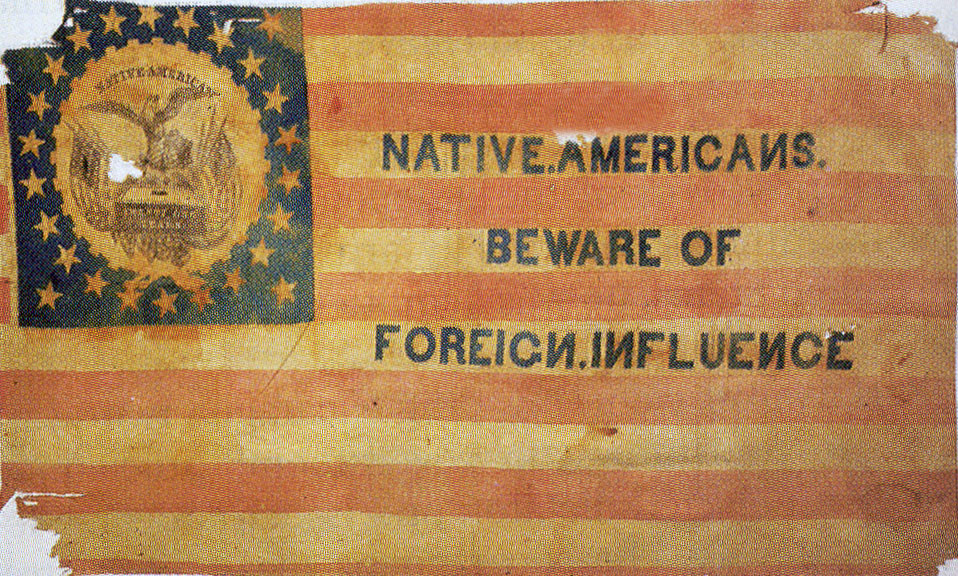 |
The item below is probably for Edward, acting as attorney for Elizabeth Arden.
"Alden, Elizabeth (Roger)Philadelphia, 29 May 1856, Elizabeth died 5 Mar 1856 [1853?], resident of Burlington Co. NJ 3 months, previously of Meadville, Crawford Co. PA, widow of former captain and brigade major Roger Alden, children . . . witness Edwin Heysham [sig.] and JP John B. Kenney [sig.] in PA, . . ." - from "Selected Final Pension Payment Vouchers 1818-1864, Volume 1" by Kathryn McPherson Gunning
In the 1860 census . . .
"Heysham, Edward, attorney-at-law, 810 Noble" - from "McElroy's Philadelphia City Directory" of 1863. This address is just south of Spring Garden street in the Callowhill neighborhood.
Edward Heysham, a lawyer, born in Virginia [?] in about 1818, died on 9 March 1868, at the age of 50, from a "disease of the lungs" - from "Martins Bench and Bar of Philadelphia," "Pennsylvania and New Jersey, Church and Town Records" and the Philadelphia Death Certificates Index, and was buried in the Odd Fellows' cemetery on 11, or 12, March 1868. Note that the Odd Fellows cemetery became inactive in the early 1900's. The city acquired the property to convert the land into the Raymond Rosen public housing development. The remains of about 85,000 bodies were relocated and placed in a mass grave in the Lawnview cemetery in Rockledge, Pennsylvania. Not all the remains were successfully removed for several caskets, a skull and marble slabs were accidently discovered on the property in 2013.
Anna moved to New Orleans, near where her sister, Mary, lived.
"Heysham Anna, wid. Edward, r. 168 Sixth" - from the 1874 City Directory of New Orleans
Mary Elizabeth Clay, a sister of Edward's wife, Anna Booth Clay, married a Adolphe Lacoste, of Natchez.
"The death of her only son [John Arnaud Lacoste] was an overwhelming blow to the widowed mother, whose only comfort lay in the fact that several of her sisters had married and settled in Natchez. Some years later, Mrs. Lacoste made a will leaving her valuable rental property Under-the-Hill to her sisters: Mrs. Anna B. Heysham, Mrs. Ellen B. Sims (wife of Mr. John Sims) and Mrs. Eliza B. Hutchinson." - from Sanguinetti/Puderer History.Anna B. Heysham died in New Orleans on 11 October 1885 at the age of 79 - from the New Orleans Death Records Index. I have no record of children. (22) Fannie [Frances] Heysham (1825)
Cited in Theodore Heysham's genealogy, per Roberts' Bios: Vol II - Part 2. Also in Banta's genealogy as Francis. She married a Hampton.
In the 1850 census of Southwark ward 2, Philadelphia county, Pennsylvania there was a Frances Hysham, 25, of Pennsylvania. She was boarding with an Ann Morgan, 72, and a variety of others.